#Also used on an Estonian book cover.
Note
Hey, I noticed that in one of your posts you showed an Iron Age Finnish woman's dress. Would you happen to have a good idea of what Finnish men were wearing in that era? The information on it seems sparse. I do have a relevant book that I'm about to look through, but I'd like to hear your insight too!
Hi! Thanks for the question (and sorry for the slow answer), I do love Finnish Iron Age clothing so it's always my pleasure to write about it. I've been wanting to do a deep dive into this for a long while, so maybe I'll do at some point a post about women's dress too.
Unfortunately no one has good idea of the Finnish Iron Age men's dress (and if you find any book or other source that claims otherwise, do not trust it), since there's much fewer archaeological finds of men's dress than women's dress. The most accepted theory on why the textiles of women's dress survived surprisingly well is because of the bronze ornamentation commonly sewn into especially the fine women's dresses of the era. The bronze protected them from decomposing fully. Presumably men's dresses were not decorated similarly then. There are some finds though and we can piece together at least some kind of vague picture.
I will be discussing the period from Viking Age to Crusade Age in Finland. Viking Age is often defined to cover 800s to mid-1000s and the Finnish Crusade Age started right after the Viking Age and ended in the end of 1200s, where the Finnish Medieval era begins. Crusade Age refers to the period where mostly Swedish (also German) crusaders in the span of couple of centuries conquered lands of the Baltic-Finnic pagans. The crusades of this period targeted pagans all over eastern Baltic Sea, including Baltic-Finnic Karelians, Livonians and Estonians, and Baltic peoples, and the Scandinavia too, where Sámi people were targeted. After that the Finland and Sápmi were colonized by Norse people and stayed that way untill Finland was transferred under Russian rule, but to this day Sápmi still stays under colonial rule, including Finnish colonial rule. The current Finland was very multicultural area, mostly populated by Finno-Ugric peoples, including Sámi people, Karelians and various Finnish peoples.
It's important to understand that even just Finnish peoples where not homogeneous, but had distinct, yet of course strongly related cultures. These were Finns (suomalaiset) (yes most people we now call Finns were not in fact called that) in the coast of southwestern and western Finland, Tavastians (hämäläiset) in central-western lake-Finland and Savonians (savolaiset) in central-eastern lake-Finland. This means we can't mix findings from all over Finland to reconstruct a dress without evidencing that all the elements were actually used in one place. These three tribes had broadly similar base for their clothes, but distinctive jewelry and detailing. The big divide was and has always been between eastern and western Finnish peoples. This is because western Finnish people were in close contact through the sea with Norse people and southern Baltic-Finnic peoples, while eastern Finnish people, Savonians mostly, were influenced a lot by their proximity with Karelians. Another dividing factor was the very different environmental conditions between western and eastern Finland. The Finnish coast especially in west is very flat and fertile land, while the lake area, especially in eastern Finland is very rocky, hilly and quite infertile. The main way it effected clothing differences was that western Finland being more wealthy had more elaborate clothing. Tavastians in both occasions fall quite in between, but they tended to be more in the western cultural camp.
My most important sources are a study by a doctor of cultural anthropology, Jenny Kangasvuo, Savon historia I (Savonian history) digitized and open sourced here and the digitized archeological collection of Finnish Heratage Agency. They are all in Finnish so not very useful for most people unfortunately.
Finnish Men's Dress in Viking and Crusader Ages
The basic garments men wore were broadly similar as women. They wore a shift/shirt, knee or above-knee length dress, cloak, belt, shoes and some kind of headwear. Wool was used most commonly, though the shirt would sometimes be linen too. Even evidence of silk has been found in some western Finland graves. I would assume that would be from a dress of some great man, who traveled to gain riches, possibly with vikings. Embroidery and decoration with metals was a typical feature of the whole Eastern Baltic Sea area. In Finland during this period bronze was the most common decorative metal, but silver was used too. Decorative elements were usually woven with small bronze spirals into all kinds of patterns. Here's examples from the reconstructed Ravattula's dress (Finns) used by women.
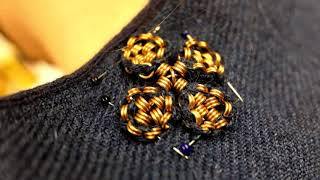

Shirt
The shirt (in Finnish shift of both women and men was called shirt) was basically a long shirt or under dress. We can assume it was similar to those of women's except shorter since the dress men wore was shorter too. They were made from wool or linen, I would assume wool was used in winter and linen in summer, when linen was even available. The neckline had a cut and closed with a bronze brooch. Horseshoe brooch was common. The first one is a quite typical bronze horseshoe brooch with a bit of ornamentation from Salo (Finns). The second one is from Tuukkala, (Savonians), it has exceptional ornate detailing and is uncommonly silver, not bronze. The third picture has two quite uniquely ornamented horseshoe brooches, first from Köyliö (Finns), second from Kurikka (Finns).
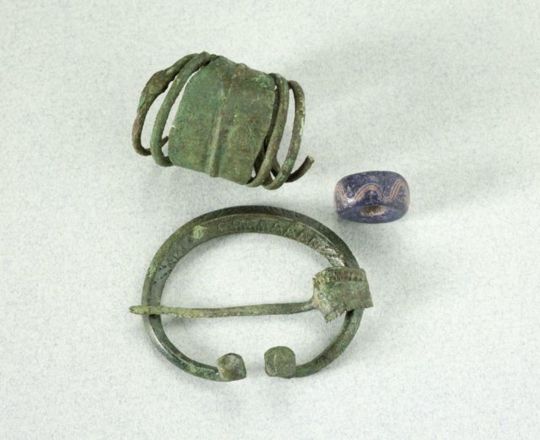
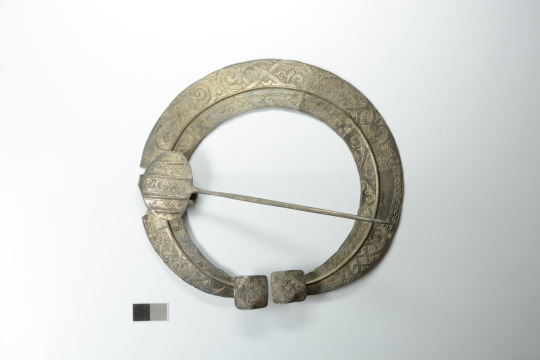
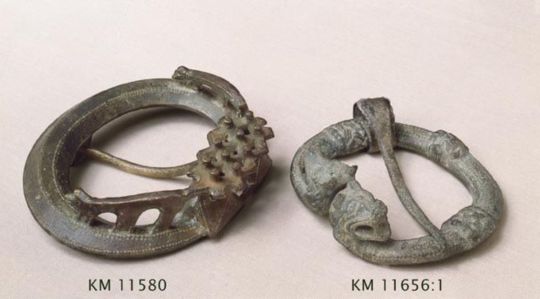
Legwear and footwear
Very little of men's legwear has survived and it's unclear weather men wore pants or separate pant legs, leg wraps or perhaps long socks. Evidence of strings decorated with bronze spirals and tablet woven band has been found in leg area of men's graves. This could mean that they wore either leg wraps, long sock or some sort of pant legs that needed to be secured with string or band under knee. Women used strings and tablet woven tape to secure leg wraps and socks, which I think supports that theory. Sometimes both bronze decorated string and tablet woven band was found in the leg area, which would still be explained by this theory, since it was common to decorate the ends of the bands with bronze decorated strings. Here's an example of sock bands just like that from the earlier mentioned reconstruction of the Ravattula's women's dress. Since men's dress was shorter, I think it would make sense if they still wore some kind of pants or separate pant legs with socks or leg wraps like that.
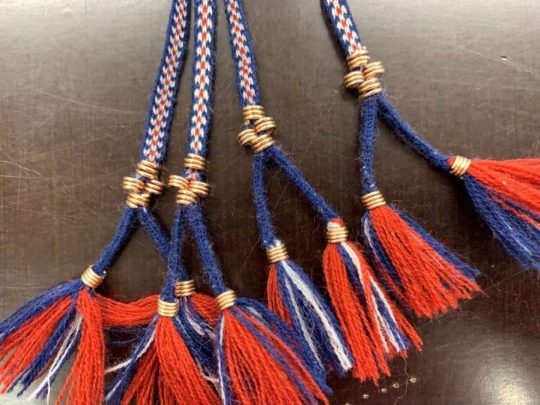
However, the strings and bands could have also been part of the shoes. Everyone probably wore similar shoes - laced leather shoes with a bit of pointed end. They might have been short or ankle length and the lacing was done with either leather cord or tablet woven band, which would also explain the findings. Socks or feet wraps would have been used in them, and straw or wool could be added as filling for warmth. Here's a pair of traditional Izhorian shoes from Estonia from early 1900s, and a pair of traditional Sámi shoes. The designs were likely roughly similar in Viking and Crusader Ages, though obviously more simple, and it's probable that Finnish shoes very something like that too. Here's a 1893 drawing of what findings of shoe material from Korpiselkä (Savonian or Karelian) might have looked like. Considering the quality of archaeology of that time, copious amounts of salt should be applied. And finally as a fourth picture there's reconstruction shoes from Ravattula's dress.


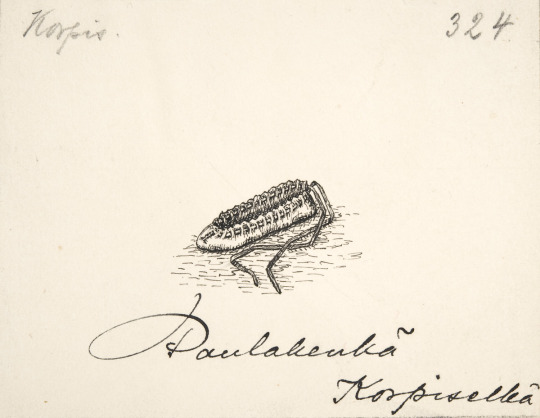
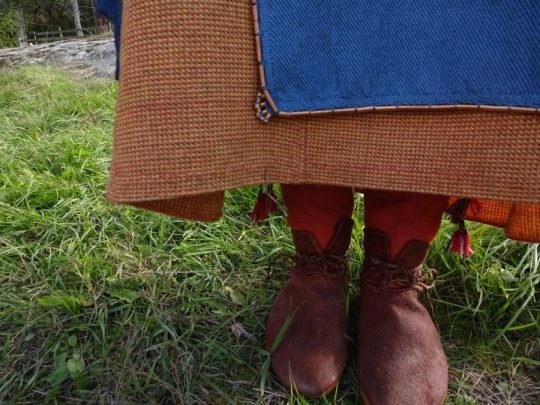
These are not necessarily mutually exclusive theories. The lacing of the shoe could have been laced up the leg and used also to secure either sock or leg wrapping, or they could have been separately secured in ankle and knee respectively.
In some graves twill fabric has been found in the leg area. It could be part of pants or for example leg wrapping, which was often made of twill. One theory about pants is that they were similar as some findings in Sweden, where fairly tight pants made of twill were secured at the hem with buttons similar to cuff studs. These kinds of cuff stud buttons are quite a common find in Finland and some have been found in men's graves close to legs.
Dress
Again there's not much findings of dresses, but a little more perhaps. It was usually from wool. The shape was either a tunic or an open coat. In Karelia there's findings of men's dress suggesting tunics thicker than women's dresses and made from sarka, a type of broadcloth. On the other hand, in Masku (Finns) they found buttons in a row on top of the torso, which suggest a coat closed with buttons. The first picture is a drawing of the grave find. Similary coak closing amounts of buttons have also been found in other places in western Finland. This suggests that Finns and probably Tavastians too wore long coats buttoned to the waist and Savonians wore tunic of Karelian influence. Below there's couple of version of what might this western Finnish men's coat dress could've looked like. The first is an imagined version of the coat based on the Masku grave finds, second is just as imagined version based on Eura (also Finns) grave finds.
Take these "reconstructions" with a strong dose of salt. These are more artistic reconstructions than scientific, since there's not enough material and too much guesswork needs to be done. And because we can see in the Masku grave drawing right here that the other deceased has a large buckle to (probably) close the shirt (to be fair, it could for a cloak too), like was typical, I find it implausible that the coat neckline would be small and round covering the buckle. If you make a decorated big buckle, I assume you want to show it. I would find a v-neckline more probable. It's also easier to make without wasting expensive fabric.

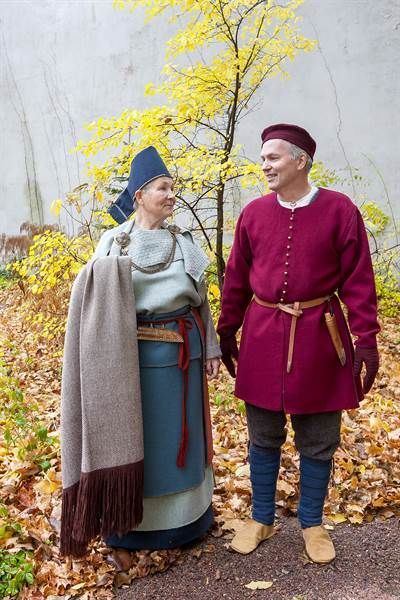

The buttons are interesting. There were what you would imagine - your typical buttons made of bronze like seen in the first artifact from Hattula (Tavastians). But then there was silver jingle bells used as buttons, found for example in both Masku and Eura graves, Eura findings pictured below.


It's possible, even probable I'd say, that the hemlines of men's dresses were finished with tablet weaving patterns, like women's dresses. Also I would assume the pattern of the men's dress (and shirt) was mostly similar to the women's underdress/shirt patterns. So here's couple of different reconstruction patterns for women's dress. Different historians have made different interpretations of the patterns, so it's very much undecided what it really was like.
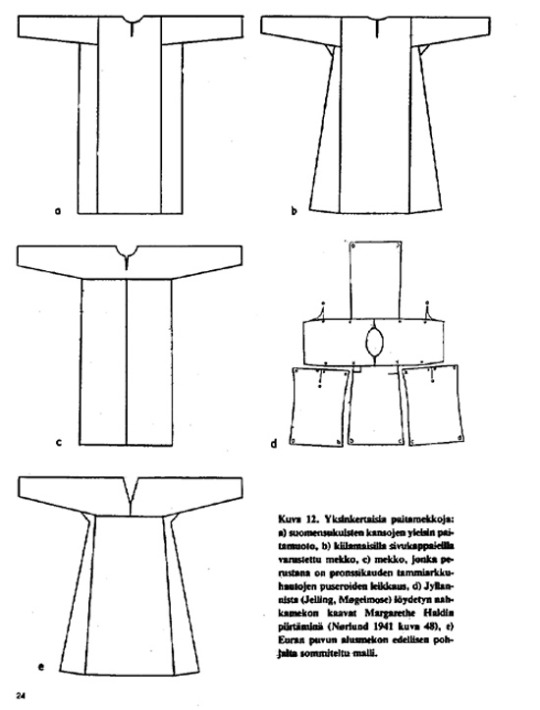

Belt
This is likely the most ornamental part of men's dress. They could be made out of leather or tablet woven band. And there's another east-west cultural divide here. Karelian belts were made out of leather, were usually 1,5-2,5 cm wide, decorated with iron or bronze studs and had a buckle made out of iron or bronze. These types of belts have been found in Savonia too, for example in Tuukkala grave find, which you can find very cool pictures of in this photo documentation of the dig in pages 173-175. In western Finland a "hela" belt was the common style. I don't think there's a world for hela in English. It's a sort of decorative lamella, small metallic plate (not necessarily square but often so) attached to fabric or leather with studs or sewing. Hela belt came from the Permians of Kama river, who were one of the many Finno-Ugric peoples who used to populate much of European side of Russia. Karelians lived closer to Permians, so you might think Permians would influence eastern Finland more, but my theory is that the costal Finns, who frequently joined viking crews and at least were in close contact with merchants including vikings, who would travel along the eastern route through the eastern European rivers, where they could go all the way to Kama river or at least meet traveling Permians. Here's yet another Finnish source more on the Finno-Ugric people around Kama river.
Anyway, hela belt was made of leather and filled with small decorated lamellas, often in square shape, but various other shapes too, like animal ornamentation. In this period hela belt helas were bronze. First image is a nice full set of hela belt metal pieces found in Pirkanmaa (Finns). Second is an older example, right before Viking Era, from Vaasa, costal settlement, (Finns), depicting a very Permian style. The third one is a lion hela found separately in Pälkäne (Tavastians). They are also found in Tuukkala, showing that both eastern and western cultural influences were present there at the same time.

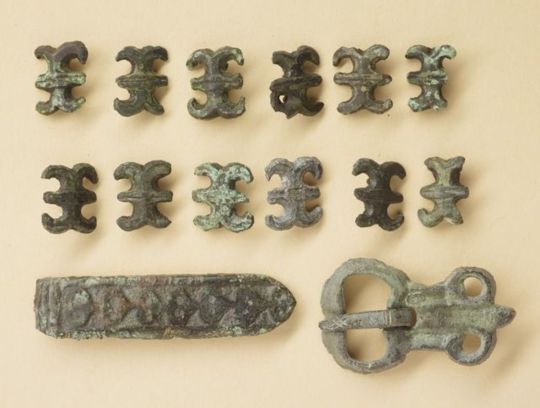
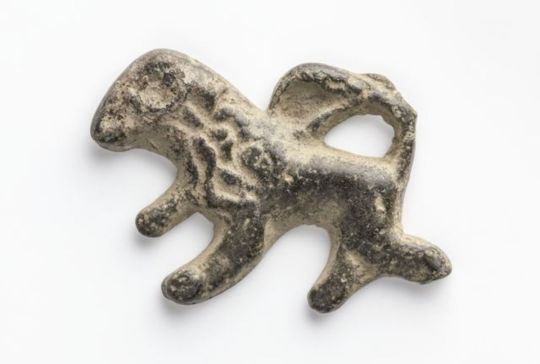
Another western Finnish belt type for men had intricate tassels decorated with bronze spirals hanging on the waist at the end of the belt. They could be made out of leather or tablet woven band. First image depicts a reconstruction of such tassel. Belts in east and west would have strap dividers to hang straps for things like purse, knife and sword. The first picture above has couple of those, but the second picture below has two more of them in more detail in the middle of the picture. These finds are from Lieto (Finns).


Cloak
Like women's cloak, men's cloak was woolen and either a square or trapezoid. Cloak is yet another east-west divide. In western Finland men's cloaks have embroidery with bronze spirals. They in fact appeared earlier in men's cloaks (in 900s) than in women's cloaks (1100s). They were also a little different in men's cloaks. The spirals and the patterns themselves were bigger and the fastening thread itself was also used for the pattern creation, unlike in women's dresses, where the thread was mostly covered. In eastern Finland there has been no finds of bronze decorations in men's cloaks, mostly only cloak brooches have been left of them. Unsurprisinly same applies to Karelia. This also means there's very little fabric left too. There's one exception. In Tuukkala (Savonians) they found a piece of fabric probably from men's cloak, though it could be from a men's dress too. It was striped, with possibly white or brown base and wide stripes of red, blue and yellow. So perhaps eastern Finnish cloak was not non-decorated, but the decoration was in the fabric pattern. Unfortunately it's hard to know how common fabric like that was, when so little of it is left.
Accessories
It's safe to assume men too wore some type of headwear, but none of those has survived. It probably means it was entirely made out of fabric whatever it was. Some type of hat or cap was certainly used in cold weather at the very least. Tablet woven headband was also possible option for not too cold weather.
In Tuukkala there was couple of interesting jewelry finds too. Two graves had a necklace type mostly found in Karelia. It was birchbark tape covered with nettle fabric and had square helas sewn into it. There were also more typical Finnish necklaces made of beads and bronze spirals.
Razors have also been found with men in their burials, so we can assume shaven faces or at least trimmed beards and moustaces were fashionable.
#dress history#historical fashion#historical clothing#fashion history#history#iron age dress#finnish iron age dress#finnish history#archaeology#answers#anon
222 notes
·
View notes
Text
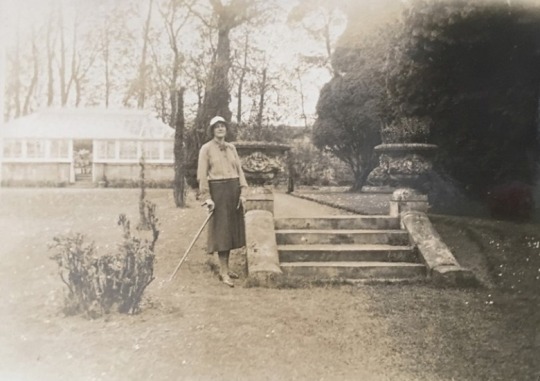
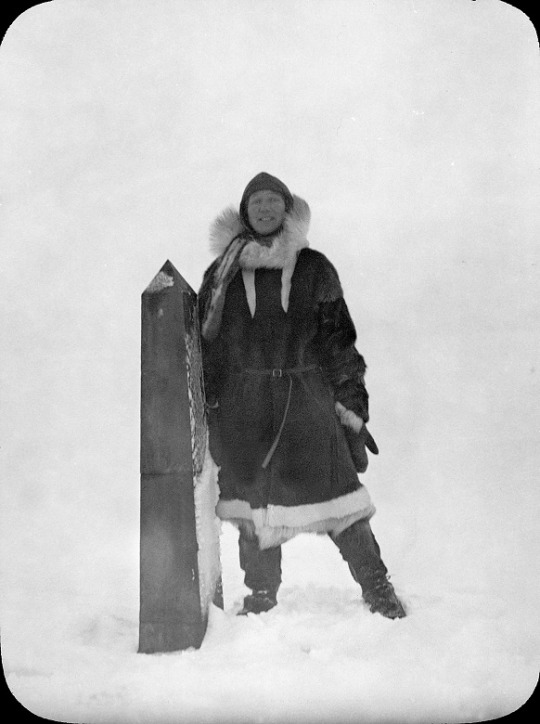
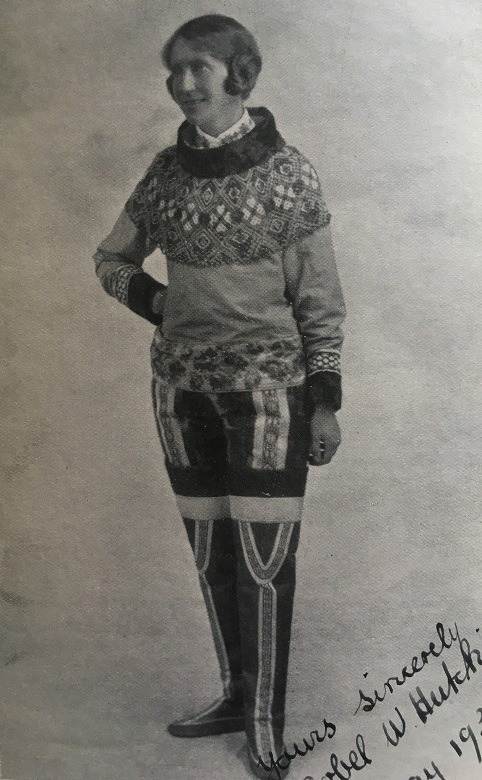


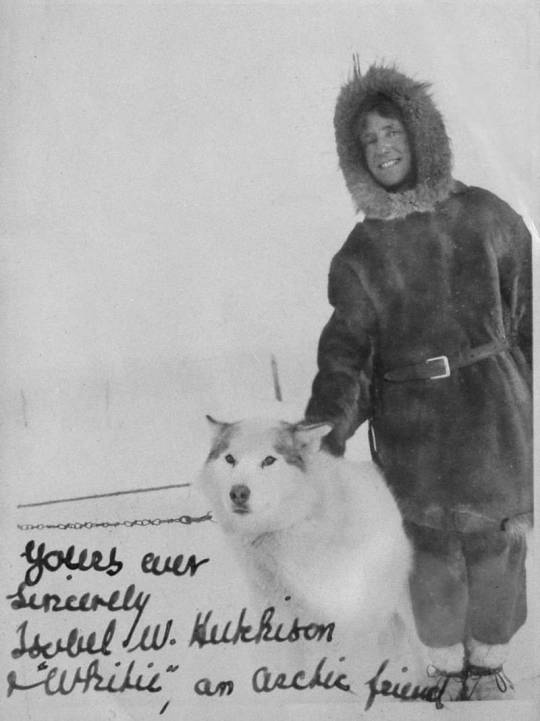
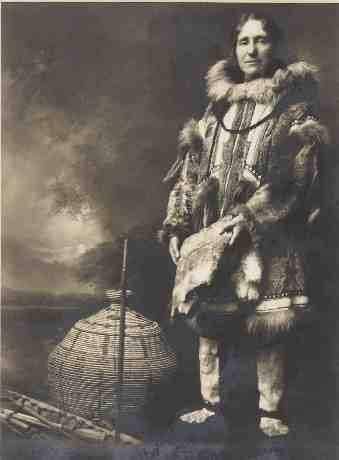
30th May 1889 saw the birth near Kirkliston of Isobel Wylie Hutchison.
This is a great tale of a remarkable strong willed woman bucking the trends and behaviour expected of a lady back in the mud 20th century.
Isobel Wylie Hutchison was an Arctic traveller during the 1920s and 1930s. She was also a botanist, a writer, a poet, an artist and speaker of numerous languages, so a bit of a polymath.
Carlowrie Castle a Scots baronial mansion was the comfortable upper-middle class home into which Isobel Wylie Hutchison was born in 1889. It was there her father, Thomas Hutchison, a successful wine merchant in Edinburgh, looked after his gardens, and passed on to Isobel his fascination for plants and his habit of meticulous note-taking. Although called a castle, Carlowrie was built between 1852 and 1855, so was never a defensive structure, but a luxurious home.
Isobel’s father, Thomas Hutchison, was a successful wine merchant in Edinburgh, he was a keen gardener and passed on to Isobel his fascination for plants and his habit of meticulous note-taking.
From 1917-18, she studied at an agricultural college, after which, she visited a number of countries around the Mediterranean region. But the sudden death or her father was subsequently followed by the loss of both her brothers. Isobel was left in a darkened place with a deeply grieving heart. Walking became her escape.
At a time when women were expected to stay at home, dressed in petticoats and tending to domestic duties, Isobel would often leave home for several days – much to the despair of her mother!
A Gaelic speaker, she had soon covered Scotland, including a trek from Blairgowrie to Fort Augustus, and began to look at bigger challenges. She wanted to spread her wings and fly away, and Iceland seemed like a good place to start.
Iceland, which she visited in 1925, was both a test and a revelation. She was told that she couldn’t walk the 260 miles north from Reykjavik to Akureyri because there were no maps, no guides, and it was far too dangerous. But she proved everyone wrong and then set her sights on another goal: Greenland.
By now, Isobel was making a name as a traveller in the Far North. She had written books about her experiences in both Iceland and Greenland. However, she hadn’t quite finished her Arctic adventures! She made arrangements to travel to Alaska and Northern Canada to explore and again, collect plant specimens. In May 1933, Isobel left Manchester and went by ship, riverboat, train and also plane, to reach Nome in Alaska.
Eventually, she arrived in Barrow, in the north of Alaska, where she transferred to another small vessel before the Arctic Ocean ice began closing in, making it impossible to travel any further. Isobel was forced to stay in a migrant Estonian’s hut for many weeks until the weather situation improved. Although her journey had come to a halt, it was an opportunity for her to visit local Inuit families, walk, travel by dog sled and stay in igloos. Eventually, she continued her Arctic trip with a 120-mile dog sled journey and crossed over into Canada. After many months in the Alaskan and Canadian Arctic she eventually returned to Scotland, having been away for around a year.
Unable to obtain permission from the Soviet authorities to visit Eastern Siberia, Isobel’s next northern journey was in 1936, to the Aleutian Islands, off the coast of Alaska. This thousand-mile long archipelago of both large and small volcanic islands draped like a gigantic necklace between Alaska and the Kamchatka Peninsula in the far east of the USSR. These islands were inhabited by Aleut people on treeless terrain and were exposed to continuous windy, foggy and stormy weather.
The Aleut people of the islands were able to live in such extreme conditions because they managed to catch a range of marine life. Fortunately, she was able to visit many of the inhabited islands by way of US government vessels. Invariably, landing on the islands involved negotiating heavy seas in wild conditions. However, when she did make land, she met with the local inhabitants, generally explored and was able to collect her plants.
The onset of World War Two curtailed any plans for further journeys into the Arctic. After the war, she completed a number of long treks, including walking from her home in Scotland to London, from Innsbruck to Venice, and from Edinburgh to John O’Groats. Isobel Wylie Hutchison passed-away at her home in Carlowrie Castle in 1982, aged 92.
The Arctic journeys of Isobel Wylie Hutchison were extraordinarily daring during a time when such trips were unheard of for a single woman. She developed a real passion for the North as she explored various regions of the Arctic world. Isobel was a true adventure traveller, enjoying the uncertainty of her journey, taking calculated risks, but being utterly intrigued by all she saw in the Far North.
15 notes
·
View notes
Text
a little while ago @crackinthecup tagged me in this bookish meme, which i have been saving for a rainy day - apparently a very literally rainy day in this case. thank you friend, i do so enjoy rambling about books <3 also tagging @hong-ara, @gloriousmonsters, @fatalism-and-villainy if you guys fancy having a go at it (and anyone else who wants to, i love reading others' opinions on books too)
An estimate of how many physical books I own: um. at least 2000. mom did some inventory once all the way back in 2006, and this was the point at which she got bored of it. i have always lived in a library and even though that many books has certainly been a nuisance, i also find it difficult to imagine a living space without them
Favorite author: honestly a weirdly difficult question. i feel like while i do read a lot for the style of prose, i don't very often go on a frenzy to read everything by the same author. but of course you all know my deep and abiding love for richard brautigan and lately i've been so obsessed with mary oliver. ...picking poets for this is easier :')
continued under the cut
A popular book I’ve never read and never intend to read: it feels funny to say this because i have literally not even once encountered talk of this author on tumblr Organically - which tends to be my benchmark for popularity - but seeing as she's all over every other bookish corner of the internet: i have absolutely no desire whatsoever to read anything by colleen hoover
A popular book I thought was just meh: WHERE DO I BEGIN... i've talked about some of these before but a new(er) addition to this list is in the dream house by carmen maria machado which ONCE AGAIN i feel so bad for not being wildly into! i think it's mostly due to the fact that internet at large painted such an interesting picture of it in terms of viewing ones own life/instance of abuse through the lens of different genres/tropes, but actually reading it, each segment was so short and the stylistic exploration didn't really come through. like it wasn't a bad book by any means and certainly covered an important topic and one that people generally shy away from, just. not at all what i expected it to be.
i tend to pick books based on genre and maybe like top few lines of the summary so i can't conjure up expectations, and obviously with popular books that's somewhat unavoidable :')
Longest book I own: extremely boring answer but my dad's bought a bunch of those 1001 books/movies you need to see before you die compilation books over the years and those all hover around the 1000 page mark
Longest series I own all the books to: if we mean series in terms of consistent cast/story, then i think it's the saga of darren shan by... darren shan, which has 12 books that i absolutely devoured when i was 13. otherwise, while i don't own every single goosebumps book (by rl stine), i do have most of them. i was very obsessed when i was 11-12 - these were actually the first books i ever read in english!
Prettiest book I own: um. honestly no clue, my family has never been one to buy books for the covers or for the special edition-ness and even now i feel like i can't picture any of them in my mind lol
A book or series I wish more people knew about: green bone saga by fonda lee!!! ...though again this might be down to the metric i use to gauge popularity, but even so! it has such wonderful worldbuilding and intricate family dynamics and even though i have big big book fear, i practically devoured them
Book I’m reading now: the silence of the white city by eva garcia saenze de urturi. it's pretty good so far! i've had such a year of thrillers and mysteries, i feel
Book that’s been on my TBR list for a while but I still haven’t got around to it: ...ancillary justice by ann leckie. i've started it a couple of times, but the Stars Were Not Aligned on those days. so i wait.
Do you have any books in a language other than English: most of the books i have are in estonian, actually. there's a pretty decent amount in english (mostly due to me...), and a small handful in swedish and finnish.
And lastly, paperback, hardcover or ebook? eboooook. often when i read an ebook i find myself daydreaming of a physical book, but then when i actually read one i find myself getting so irritated by not being able to find a comfy position lol. i also really love audiobooks, for the multitasking value...
10 notes
·
View notes
Text
My Journey (Fashion Design)
I'm obsessed with fashion, please let me know if there's a 101 class, blog or something else cause I want to know more! Keep learning...
So far what I've been doing it's:
* Learn how to draw (actually taking classes and I'm currently an art student)
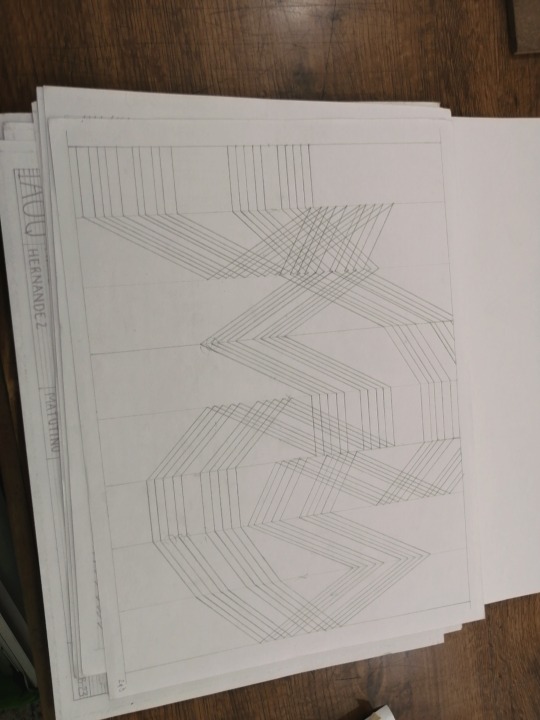
* Reading books 📚 about the topic (if you all want me to come up with some titles I'll make it happen, just let me know in the comments) but here are some for now:
♡ The Sewing Bible by Ruth Singer
♡ Overdressed: The Shockingly High Cost of Cheap Fashion by Elizabeth L. Cline
♡ Fashion Design: The Complete Guide by John Hopkins
♡ So you want to Work in Fashion?: How to Break into the World of Fashion and Design (Be What You Want) by Patricia Wooster
♡ Trash to Trend (a doctoral thesis, Estonian Academy of Arts)
♡ Patternmaking for Fashion Design
♡ Sewing for Fashion Designers by Annette Fischer
♡ Atlas of Fashion Designers by Laura Ecceiza.
(I have more of course, but the list is quite long.)
* Downloading some apps (Vogue Runway happened to be so interesting!)

* Learn how to draw online thanks to several YouTubers + downloading some drawing apps
I still suck, but I'll get better!
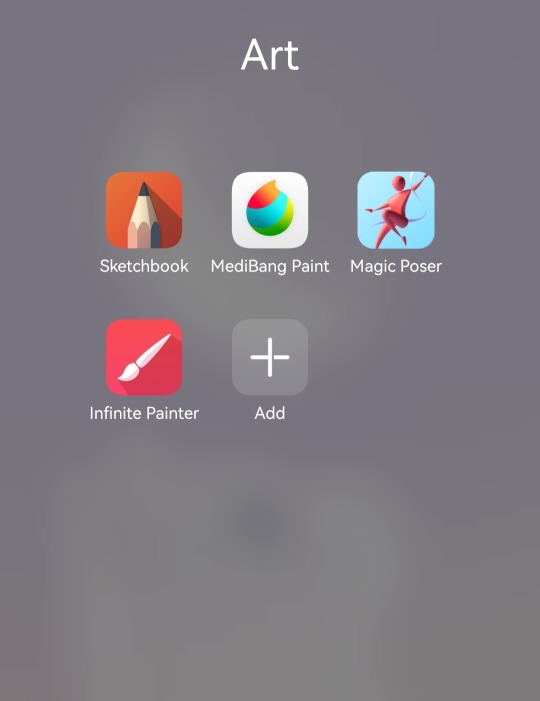
* Listening a lot of music
* Learn some psychology and color analysis
* Read books that have nothing to do with it such as novels, because that makes my heart flutter and my mind gets creative. Sometimes I even try to draw something that some of the characters might be wearing...
* Bought myself a sewing machine
* I'm trying to have enough patience to figure out how to use it (thanks again YouTubers, for making my life so easy 😭🤧)
* Acknowledging how fashion industry especially fast fashion is contaminating our planet (check out this blog!) and trying to figure out the way to start with sewing but I'm too intimidated by it rn 😭💀
* Studying how to re-do my portfolio, (because thank you internet for existing!)
* Studying make up on my own and learning some of the basics of cosmetology, because that's another passion of mine.
* Studying business and fashion marketing
* Realizing that technology is advancing so fast, nowadays there's even sprays that can create dresses or AI combining with holograms that will make our life as designers a bit more easy when choosing a fabric. But they can also put everything at risk if there's nothing to protect us as humans that create these beautiful clothes we use every day.
Keep in mind that I'm a self taught student. Sometimes I take classes to cover certain aspects but I don't think I am an expert at all in the field. If you have a recommendation, a comment or something you want to share to help me with my path I would really appreciate the feedback.
I'm currently looking for YouTubers that help me covering the basics of sewing and learning about fabrics, especially about fabrics! I'll keep y'all posted.<3
9 notes
·
View notes
Photo

Charms, Charmers, & Charming: International Research on Verbal Magic brings together the work of many of today’s key scholars in the field of verbal charming. The essays it contains cover vernacular magical texts and practice from Malaysia to Madagascar, & from England to Estonia. As the most comprehensive collection of research on charms, charmers, & charming available in the English language, it forms an essential reader on the topic. Obtain at #TheWitchery via https://www.thewitchery.ca/product/charms-charmers-and-charming-international-research-on-verbal-magic/ 'In this ‘New Age' of mass production of manuals of magic & Wicca-books, it is amazing how little scholarship has been produced about practical uses of magic, past & present. This rich book, authored by the leading charm experts, provides us not only with pieces of verbal #magic, but also with interpretations, discussions & thoughtful comparisons. #Charms, once considered a minor genre of #folklore, are here opened up as a powerful source of diverse knowledge about #European heritage, human thought, worldview, social conflicts and about magical solutions that #charmers have offered to crisis situations worldwide.' - Ülo Valk, Professor of Estonian & Comparative Folklore, University of Tartu, Estonia, and President, International Society for Folk Narrative Research Hardcover & cheaper then Amazon https://www.instagram.com/p/CncYKf3JsDw/?igshid=NGJjMDIxMWI=
1 note
·
View note
Photo
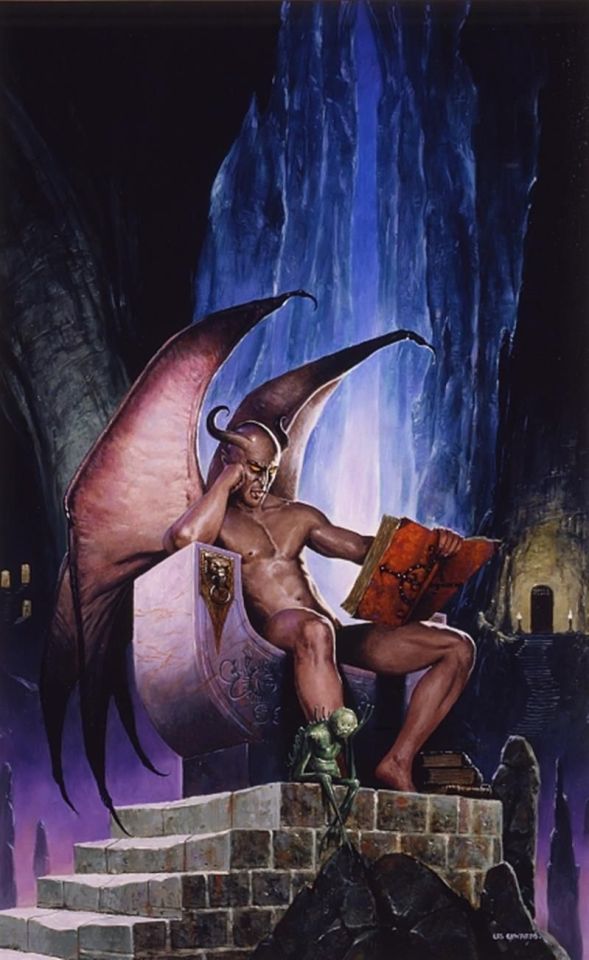
𝔏𝔢𝔰 𝔈𝔡𝔴𝔞𝔯𝔡𝔰
#Les Edwards#Dark Voices#Anthology edited by David Sutton and Stephen Jones including stories by Peter Crowther#Les Daniels and Nicholas Royle. Published by Pan.#Art#Illustration#artwork#devil#evil#satan#books cover#magazine cover#Also used on an Estonian book cover.
428 notes
·
View notes
Text

About Estonian
"Did You Eat the WHOLE Cake?" On Learning Estonian by Judith Knott (Deep Baltic) | “Estonian is popularly known as a difficult language to learn. Much of its vocabulary is unfamiliar, as the only other national languages it’s related to are Finnish and, more distantly, Hungarian. It’s even been described as the most difficult Latin-alphabet language for a native English speaker, and some of its features have assumed an almost mythical status. From my experience so far, I would agree that it’s challenging, but one of the coping strategies is to focus on one’s own reality as a learner (which will be different for each individual) and not be daunted by the myths.”
The Estonian Language by Urmas Sutrop (The Estonian Institute) | A booklet covering the history of the Estonian language, an overview of grammar and syntax, and information on dialects and related languages. (FR/GER/SWE)
Online language programs
Keeleklikk / Keeletee | These online, multimedia programs from the Estonian government cover levels 0-A2 and B1-B2, respectively. Both include feedback and correspondence with professional Estonian language teachers (all free!).
Speakly | This program is most similar to Duolingo, and has extra features like listening exercises to explore. If you look around the internet, you can often find a free code. And in 2021, there is a new simplified free version on mobile.
Some quality older resources have gone offline: Lingvist’s short course in Estonian, and Kultuuriklikk, a companion to the Keeleklikk series that introduces Estonian culture at a B level. I hope they will be back some day!
Language textbooks
E nagu Eesti / T nagu Tallinn / K nagu Kihnu | This widely used series is the current standard for classroom instruction. Independent students may find it a challenge, because while there are EN/RUS/FI glossaries, all of the teaching is in Estonian.
Estonian Textbook | Though the author is now also recognized as a Soviet spy, this book contains some of the best explanations of Estonian grammar available in English.
There are other widely available Estonian books, such as from the Teach Yourself or Colloquial series. I don’t think they are as focused or well-organized as the texts above, but it’s not to say you can’t get some value from them.
Media
Television | Eesti Televisioon is the national public broadcaster in Estonia. Its native language programming is mostly free to stream worldwide. See what is airing this minute in Estonia or browse the archive.
As far as I know, there isn’t a “slow news” service, but some programs have closed caption options. People tend to speak more clearly on the chat shows, although the subject matter can be more abstract than on scripted TV.
Music | There’s more to Estonian music, but the Laulupidu is a good place to start. The Üheslaulmine from 2018 is a more casual sing-along.
Podcasts | Many options among those listed at podcastid.ee and the public radio podcasts at Vikerraadio. One to check out is “Järgmine peatus,” where guests share their travel experiences (Estonians love to travel!).
Newspapers and magazines | Some old school newspapers are Postimees and Eesti Päevaleht. On the magazine side, Anne & Stiil is something like Estonian Cosmo. Sirp and Müürileht are higher brow cultural magazines; Edasi follows current affairs.
Online dictionaries and tools
Eesti - Inglise - Eesti sõnaraamat | Estonian - English dictionary.
Sõnaveeb | An Estonian-only dictionary, but one with a great interface and extras like verb conjugations, and a simpler version for language learners.
Eesti keele seletav sõnaraamat | A dictionary that provides correct examples of word usage.
Sihitisesõnastik | A dictionary to find the correct object case of a verb.
Eesti Keele Instituut | Home of many more specialized dictionaries and resources.
Filosoft | Tools to find word stems and conjugations and declinations.
#estonian#eesti keel#langblr#estonian language resources#finno-ugric#suggestions and corrections welcome obvi!#i may add a section on idiosyncracies for someone learning from an english base#but this seemed like enough to start
371 notes
·
View notes
Text
King Harvest Dancing In The Moonlight Old Shop Stock Sealed Vinyl Record Plp 36 £40 00
Rita Bradshaw was born in Northamptonshire, where she still lives today. At the age of sixteen she met her husband - whom she considers her soulmate - and they have two daughters and a son and four young grandchildren. In any spare moments she loves walking her dogs, reading, eating out and visiting the cinema and theatre, as well as being involved in her local church and animal welfare.
Now it seems like everyone is using it, no matter their age. Its growth has come at the expense of its competition, such that just about every social-media company is now pouring money into copycat products. Just a few years ago, China-based BiteDance TickTock was an app for kids that featured videos of ethnic pets or strangely talented children dancing. Now it seems that everyone is using it, regardless of their age.
The Chinese saw in the lights fire-breathing dragons; the Fox Indians of North America believed that they were the ghosts of slain enemies and harbingers of ill fortune. Canadian Indians saw in the lights the spirits of ancestors engaged in a celestial ball game involving a walrus skull; Estonians thought the displays heralded war; Finns saw in them the sweeping tails of Arctic foxes. More cheerily, the Scots believed they were merry dancers. Although the band have been produced by Jack Antonoff for the first time, there’s no big shift in their melodramatic brand of sweeping pop-rock, richly gilded with baroque swirls of brass, harp and woodwind. I suspect Antonoff (who has a tendency to make records sound like they’ve been recorded in expensive underground swimming pools at 2am) is behind some of the murky bass lines and woozy reverb.
Toploader will play on Saturday August 31 alongside Big Country. Two further big name acts are set to be announced to play on the Sunday with a free night of entertainment scheduled for Friday evening. Last week 80s rockers Big County were announced as the first headline act for the 2019 event and now it can be revealed they will be joined by alt-rock band Toploader, famous for their top ten hit Dancing in the Moonlight. This year marks the twentieth anniversary of the band's debut album 'Onka's Big Moka’ being released. Do an advanced search in works of art, names, books, exhibition catalogues, archives, or frames. She likes exploring new games and still has nightmares about the moon from Majora's Mask.
Images are printed on professional matte paper with a weight of 100lb / 189gsm and each image is limited to only 250 reproductions.
Once you've purchased a song, all subsequent mixes are unlimited and free.
When war erupts, Beth's peaceful life is shattered by events beyond her control.
Teen tourists, Laura Kay, 14 and Hutton Phillips, 14 dance their way through Faneuil Hall to thanks to the beat of the band, Half Moon.
But Friday's fundraiser will be held at the David Evans Court Theatre, also in Tring. I guess you'd be tempted to say that both bands were one-hit wonders, too, except that Looking Glass had a followup that no one remembers ("Jimmy Loves Mary Anne"). My new favorite part of this beloved oldie is the chords at the transition from intro to first verse. Lime Cordiale and Miiesha have performed a cover of ‘Dancing In The Moonlight’ for ABC music TV series The Set. We want you to feel comfortable and confident when shopping at Jeulia, that’s why we offer an easy 30-day return & exchange policy. Please make sure there's enough space to tuck in 2 fingers as this is the space you need to add the charms.
Theatre Review: Dancing In The Moonlight: A Play About Phil Lynott, Riddle's Court, Edinburgh
Toploader Dancing In The Moonlight Black Guitar Song Lyric Music Art Print We also have 1000's of other songs available, but If you cannot find the song you require by using our website search... Toploader Dancing In The Moonlight Vinyl Record Song Lyric Print We also have 1000's of other songs available, but If you cannot find the song you require by using our website search facility, then... Laura Greene Moonlight, Music and You Vinyl Record Song Lyric Print We also have 1000's of other songs available, but If you cannot find the song you require by using our website search facility,... Barry Manilow Moonlight Serenade Vinyl Record Song Lyric Quote Print We also have 1000's of other songs available, but If you cannot find the song you require by using our website search facility,...
The Story Of 'as' By Stevie Wonder, Covered By George Michael And Mary J Blige
Lion dance perform entertains visitors to celebrate the lunar new year of the Tiger at a shopping mall in Bogor, West Java, Indonesia on February 1,... Lion dance entertains visitors to celebrate the lunar new year of the Tiger at a shopping mall in Bogor, West Java, Indonesia on February 1, 2022. Lion dance perform entertain shoppers to celebrate the lunar new year of the Tiger at a shopping mall in Bogor, West Java, Indonesia on February 1,... Lion dance perform entertain visitors at a restaurant to celebrate the lunar new year of the Tiger at a shopping mall in Bogor, West Java, Indonesia...
They went on to back Robbie Williams and Bon Jovi, becoming the last British band to play the original Wembley Stadium. "The schedule this summer has been crazy and I think it might be the busiest summer we've ever had," he says. Dan, 43, and the rest of the band have certainly been relishing the chance to play wherever they can this summer with a punishing schedule helped by the fact they've been able to catch up with a number of close friends along the way. Tesla boss Elon Musk tweeted that his plans to buy the social media platform were on pause over reports about the number of bots and fake accounts. WHILST Storm Dudley and Storm Eunice leaves us bunkered down for a couple of days, thankfully however, it looks like it'll drift off by the weekend. For us the personalization of interiors is a form of contemporary storytelling.
http://urlm.co/www.pcdance.co.uk
Etsy is no longer supporting older versions of your web browser in order to ensure that user data remains secure. Established in 1875, Wright & Round is one of the oldest publishing houses in brass banding and its catalogue carries in excess of 5,000 titles. Swedish electronic duo Jubel recorded a dance cover in 2018, featuring vocals by their fellow Swede, Neimy. Sherman Kelly's brother Wells Kelly then introduced the song to his band King Harvest, in which he was drummer. Former Boffalongo member Dave 'Doc' Robinson was also the lead singer, bassist and keyboardist. 'Dancing in the Moonlight' has had one of the most fascinating journeys and histories, from its first hit version by King Harvest, to its most famous cover by Toploader, to its modern day update by Jubel.
All the files you've already bought are available in "My files". Rockol only uses images and photos made available for promotional purposes (“for press use”) by record companies, artist managements and p.r. Sign up to the Best of Pan Macmillan newsletter to discover the best of our books, events and special offers. Capturing the true variety and excitement of the festival, music fans will be able to register online for free here and tune into one of seven simultaneous channels across the two days, running from 6pm until 8pm each evening. Elsewhere in the northern hemisphere, there have been a host of other interpretations.
2 notes
·
View notes
Note
korest (south korea x estonia)
Finding Solid Ground
Magical AU, early 1900s
Ship: Korest (South Korea x Estonia)
AN:
If I was a better writer (and more efficient one) I swear I could have completed this. It started as a 1K, grew to 4K, and is still incomplete! Such a frustrating thing writing is.
I am a college student taking difficult courses this semester, and to be honest a little burnt out from working on this… so unfortunately this WIP has been put on indefinite hiatus (don’t fret! I have ‘finished’ it with an ending, albeit a kind of bittersweet one. However, most of this piece has not been written and/or edited yet). For now, the story has multiple flaws: weak research, a lack of continuity, and a lack of meaningful scenes: it’s a first draft. However, I still think there’s lots of good parts in it too, plus I feel like I should respond to an ask that is like 5 months old by this point. I have peppered in Author’s Notes to supplement some of those weaknesses. The further into the piece, the more frequent AN’s will pop up. All AN’s will be inside “<” and “>” like <this>. It’s a tad cringey and reminiscent of early 2000s fic, but it’ll have to do. Anon and anyone else reading this, feel free to take what I wrote and continue it. Parts of the good in this that can get salvaged? I think it’s a rather interesting AU, and would be honored if people expanded on it. Just please make sure to credit me.
I didn’t have great world building in my writing, so this is a brief introduction. The setting? Middle of nowhere Korea, early 1900s. I have blended elements of history and fantasy. The “magic” here can either be inherent (like magical powers people are born with) or learned (Like in Harry Potter where the people have to learn spells to actually do anything as a wizard/witch). Additionally, sort of like a hunger bar in Minecraft, “magic” can run out when the magic user is tired/famished/overusing spells. There are only a few people in this AU that have magical power. Think of it as I made the Hetalia cast have magic in place of their immortality.
TL;DR: Anon, I spent a whole lot of time on this to no avail. I think I ship Korest now though.
---
The first thing Eduard saw was a night sky. Moonlight streamed through soft clouds and stars peaked behind gaps. Beautiful.
But then, a cold wind whooshed past his ears and bit into his skin. He glanced down. Then, his eyes widened in shock. The trees looked like tiny, snow-covered bushes from up here.
Teleport!
Nothing happened. Shoot. Why did his powers have to fail him now?
He flailed, his arms grasping at thin air as he plunged toward the earth and braced for impact.
“AGH!”
His right shoulder lit up in pain as it crashed into a branch. Crack. He hung there for a second, the branch swaying dangerously before it fell away from the trunk, dropping him lower.
“Oof! Gah! Eouh! Tss!”
He was out of breath by the time he landed on the frost-sprinkled forest floor. He was dazed, soaking in what just happened. The leaves and snow softened the blow of the fall, but his shoulder still stung. It didn’t help that a bit of his blood was trickling out in the snow. His head throbbed dully. He propped himself up with his arms and his glasses fell off his face.
Now the world was a blur, including the glasses themselves. He narrowed his eyes and brought the glasses up closer to his face. They were broken along the bridge, split into two halves. He brought the right lens closer. The glass had a crooked vertical gash running through it, ending with a broken rim. He picked them off the snowy ground and placed the pieces into his pocket. Slowly, gingerly, he stood up. He hobbled over to a tree and leaned against it.
“Hello?” a voice asked in the distance. Eduard blinked, trying to keep his eyes open. He shifted his head to look toward the sound, but all he saw was a blurry forest and a faint glow far away.
The last thing he remembered was the world turning to black.
---
Eduard drowsily opened his eyes to see a small room. He was in a bed with a thick comforter. It was dark, the windows showed a navy blue night outside.
Out of the corner of his eye, he could see a stranger walking over with a lit light source, eerily warm for being so small. That’s all Eduard could tell without his glasses. He touched his pocket, relief pouring in when he felt his eyewear. But he still felt tense. One thing was certain: this was an unfamiliar place, he had to get out of here. He tried to muster the energy to teleport, but his body stayed firmly in bed. His magic still wasn’t working it seemed.
“You’re awake.” The man noted, walking over to him.
“Who are you? Where am I?”
“I’m Yong Soo.” The other man said. Eduard narrowed his eyes, trying to make out Yong Soo’s facial features. But it was still too blurry. “I found you passed out on the forest floor and thought to bring you home. But first, no weapons please. Empty your pockets.”
Yong Soo respected him enough not to ruffle through his things. Not that Eduard had anything to defend himself with anyways. Reluctantly, he decided to take out his broken glasses. The man took them and examined the pieces.
“You better not take my glasses for long.” The threat sounded empty, even to Eduard himself, but it felt better than nothing. Being in an unfamiliar place with his blurry vision was putting him on edge.
“Don’t worry about them,” Yong Soo flippantly responded. “Now, my turn: how did you end up in this forest in the middle of nowhere?”
That question stilled him. Eduard wondered how to logically explain falling out of the sky without the use of magic.
“I… don’t know. I didn’t mean to land here. And you still haven’t told me where I am.”
Yong Soo gently placed his lantern on a nearby table. “We are kind of a new country. I do not know if you know about us, Mr. Sorcerer.”
“Sorcerer?”
“Magic user.” Yong Soo recited an incomprehensible (at least to Eduard) verse and waved his hand. The lantern slowly got brighter.
Eduard sucked in a gasp: that move was powerful. All he knew was transportation spells.
“I’m pretty sure it’s my fault you ended up here.” Yong Soo gestured with his hands, trying to describe his thoughts. “A sprinkle of magic and a bit of boredom, and… poof you’re here now. The spell I used attracts other ‘magic users’ like you and me. I was trying to get my brother, but looks like I can’t get to him for some reason” He sighed, as if he had something more to say but didn’t have the words. “Anyways, I am sorry for barging into your life. Hope that this somewhat makes up for your fall.”
Yong Soo grabbed ahold of Eduard’s hand. Lightly, he nudged Eduard’s fingers so that the palm of his hand would face up. With a flick of the wrist, he produced fully fixed glasses and laid them between Eduard’s thumb and pointer finger.
“Woah...” Eduard whispered in disbelief, examining Yong Soo’s work. There were spells of all kinds, but he never saw one that ever smoothly put objects back together like this. He put his glasses on and looked at Yong Soo. His blurry vision became sharp.
The clothes Yong Soo was wearing were so different from the stuff back home. Eduard didn’t have the vocabulary to describe them. He wore something akin to a dress, and the waistline was high, right under the chest. The top of the outfit had long sleeves that were wide, hanging down instead of staying tight around the wrist. He also held a thick book in one hand, part of it hidden under the sleeves.
The light from his lantern lit him up so that his pale beige skin contrasted with the darkness of the room. Dark brown eyes and ink black hair, a flyaway curl sticking out the side. An Eastern Asian man. There was a happy smirk on his face, one that triumphantly proclaimed that he succeeded in fixing the glasses.
“Just a simple little time reversal spell” He tapped on the edge of the frames for emphasis, and Eduard pushed his glasses back up with a huff. “Keep those safe, they’re expensive.”
“Now could you please tell me where on Earth I am? I know I’m not at home.”
“Korea. A bit ago we were Joseon. Now, what’s your name traveler?”
“Eduard.” he paused, trying to grasp everything that was happening. First things first: “How long has it been since I got knocked out?”
“A few days.”
“Shoot.” Eduard sat up and got out from the covers, ignoring the sting from his right shoulder. “I’ve got to go. Back. You know. Before I got transported to this place.” He tried to muster up the energy to teleport out, but, ever frustratingly, his body still didn’t budge.
“Well. How do you even begin doing that?”
“If I could just…” Eduard concentrated, envisioning his home, and pulling himself mentally closer. But nothing happened. Eduard inwardly groaned.
“Okay there?”
“You don’t understand.” Eduard grumbled, trying to avoid worsening his wounds as he shuffled back under the covers. “Before I teleported, I was writing up this article. I’m part of a team attempting to get an Estonian newspaper off the ground. And well, it’s important to me for my article through… that sounds odd but let me put it this way. Though it may sound simple, it could propel us to become our sovereign nation! Independence, that’s something that has been a rarity. And with all the Russification going on, it’s been rough going.”
<Above probably needs development, I don’t know much about this topic and did minimal research>
Eduard paused. “Wait a second, how the hell are you speaking Estonian?”
“When I saw that you were European,” Yong Soo showcased the thick book he was holding, “I used up my resources. I searched up a spell that would break a language barrier. Unfortunately, due to my own lack of language skills, I wasn’t able to understand that deciphers written words unfortunately. Then it would be easier to read this damn thing”
Eduard looked toward Yong Soo’s spell book. He recognized the Latin letters, but not the language of the script. “Now where’d you get this from?”
“I got it from a... ” He hesitated, “An acquaintance. From out East, Japan. And he got it from a British guy. My acquaintance is not on good terms with magic, even if he was once enthralled by it, and so I bought it from him.”
Eduard heard rumors of a strong British sorcery. The spell should be pretty good.
Yong Soo kept going. “It was a good choice too. I have translated some spells in here and they are the only things keeping me from going bonkers. I isolated myself in the middle-of-no-where after all. Turns out it’s good to have a companion, even if that companion is a book.”
Eduard looked at the spell book, intrigued. “Since I can’t go back home anyways, should I test to see how well your spell holds up?
“Aren’t you already doing so? With, um, Estonian, right?”
“Well, if I *speak Russian you’ll understand me?*”
Yong Soo nodded. “Your accent changed a bit though.”
“And, *if I stretch it… do you understand some broken German?*”
“I do.”
“How about-”
“Hold on. How do you know so many languages?”
Eduard frowned a bit, pausing to understand what Yong Soo was asking. “I’m a polyglot.”
“Yeah, I just so happen to be a polyglot too. But I learned about other languages out of necessity. I used to have a life of splendor, politics, and drama.” He pointed out the window. “I took a break from that by moving to a place with more trees instead of people. Right here. Now, what… ‘normal’ man would be that talented? There has got to be a driving factor.”
Would it hurt to tell this Korean man about his life? If Eduard teleported out of here as soon as he could, it couldn’t do damage. “I told you earlier, I work for a newspaper. Using language, even other languages too, are my thing. At the same time, polyglots aren’t rare back home. I guess that’s what I get for being born into a place that got bulldozed over by neighboring powers continuously. The place gets pretty bi and multilingual. Other languages get impressed onto us.”
“By… ‘Us?’ You mean, ‘Estonians?’ Of a country that doesn’t exist?”
“Yes.” Eduard said it with finality.
The Korean man seemed to be mulling over the words, unease spreading over his expression. “I wonder...” Yong Soo stopped abruptly. He walked over to a makeshift kitchen area. “I wonder if you like pickled, spicy food.” He beckoned Eduard to come over too.
“Pickled, yes. Spicy, no. Plus, I told you I have to go back home somehow, even if it is too late.”
Yong Soo looked at Eduard with a knowing glint in his eye. “If you could teleport back now, you would have already.”
“You’re not wrong.” Eduard gestured towards Yong Soo’s hands. “But, you also have a spellbook in your hands. If you really wanted to help, you would have given me a magic boost. I would have been on the way.”
Yong Soo frowned. “I don’t even think there’s a spell for a magic boost. I could be wrong though. I got this book very recently and only a few spells have been translated.”
“That means?”
“Considering the fact that you being here is the combination of both my magic power and yours, it seems like the way back is if I incorporate my magic with yours once more. Unless you can teleport for long distances, you’ll have to stay here with me.”
Eduard felt his heart plunge. They were quiet after that statement.
<AN: Eduard has a hard time dealing with this new reality that he has to stay in an unfamiliar place. I didn’t give enough breathing room to write his experience with that.>
Yong Soo pointed toward a dish on the table. “I’ve got some cabbage-based kimchi. I have been living on this stuff for months here in the middle of nowhere.”
Eduard walked over to the table, looking over the unfamiliar food. “What are... these?” He tapped on a small porcelain bowl filled with cooked white grains. Then he gestured to two evenly shaped straight sticks, each about the size of a rectangular-ish, thinner, flatter pen.
“A bowl of rice and chopsticks. Of course.”
Eduard searched around. “You don’t have forks?”
Yong Soo looked up at Eduard and a tangible pause lingered in the air. “Ah. You don’t know how to use chopsticks, do you?”
Eduard crossed his arms. “Look, I appreciate this, but I can’t even eat the food you’re offering me.”
“Well,” Yong Soo took the chopsticks for himself, showcasing how they were used. “I could teach you.”
Eduard’s stomach growled, as if on cue. He sighed, grabbed the chopsticks, and looked up at Yong Soo. “Well then. I guess I’ll have to learn.”
“First of all, you're holding it wrong.” Yong Soo picked up his own pair and let Eduard see his hand. “You raise and lower the top chopstick. And then you can do this.” He grabbed a piece of the cabbage kimchi and lifted it over to his bowl of rice.
Eduard fidgeted with his hand. He tried to ignore the feeling of embarrassment while trying to get a semblance of the position.
Yong Soo let go of his chopsticks and leaned forward. He guided Eduard’s hand to the right position. He backed up after he was satisfied. “Now try it. Move the chopstick above up and down.”
Eduard tried to focus on his shaky hands. He slowly nudged the chopstick up, but then the lower one clattered onto the table. Yong Soo smothered a giggle.
“Hey, hey now. I’m a beginner.”
“I know, I know.” Yong Soo smiled at Eduard and handed him the fallen chopstick. “Try again.”
Eduard eventually got the hang of the chopsticks. He tasted a bit of the food, gritting his teeth at the unfamiliar taste of kimchi.
<AN: Yong Soo insisted it was a very common Korean staple, and concluded that Eduard just had a low spice tolerance for the red chili pepper.>
---
“You know what? I think I’ve rested for a couple of days, I should try a simple transportation trick. Transporting objects and people are my inherent abilities.”
“I say go for it.”
Eduard laid his chopsticks on the table and shook out his arms. Then, he closed his eyes and concentrated on the chopsticks, making sure to stay a bit away from them. “Come to me now…”
The chopsticks vanished in a shower of sparkles. Eduard looked toward his hand expectantly. They didn’t appear.
“Oof!”
A disgruntled Yong Soo pulled the chopsticks out of his hair. He handed them to Eduard. “They tumbled from the ceiling and ran into me.”
“Are you okay?”
Yong Soo rubbed his head and then cracked up in laughter, “I don’t know about you, but I think you need to rest a bit more.” He tapped on the thick spellbook, “Maybe we can look through this together in the meantime.”
“Sounds fine by me.”
---
<AN: Brief continuity error below.>
“There’s something that’s been weighing on my mind Yong Soo. I normally travel short distances. How the hell will I get back home to Estonia?”
“You could make pit stops?”
“Not everyone is as hospitable as you, Yong Soo. Who knows what situation I could end up in.” He sighed, closing his eyes, taking off his glasses, and placing his head in his hand. “I've already been gone for awhile now. If I go back, I’ll get lost and be gone for good.”
Yong Soo looked up, at least that’s what Eduard could tell from his blurry vision, and stretched out his arms. “Well I am trying to work through this spell book to help you.”
“How are you translating it? Can you read English?”
“What do you mean?”
Eduard put his glasses back on and pointed at the spellbook. “The book’s in English, right? You said it was originally from a British sorcerer. I’m wondering if you can read it.”
“I can’t, not really well. But I did get my hands on this dictionary: English to Korean.” He lifted up a second, smaller book for Eduard to see. “I wrote a few notes for myself in the margins.” He pointed toward some notes on the sides. “English… is very different from what I know. Letters versus characters. It’s hard to decipher the text.” Yong Soo gave him a tired look, “You’re lucky, you know that? This dictionary was a really hard find. Without it you’d be stuck here with me until you walk to a port on foot and find a boat headed to Europe. The process is still extraordinarily slow, and I don’t know the vast majority of spells in here at all.” He looked back down to his book.
“Thank you for all this work you’re putting in for me. As a speaker of many European languages, maybe I could help?”
Yong Soo considered it and opened the spell book and the dictionary for Eduard to see. “Why not.”
<AN: they look over the spell book and determine which spells would be useful. This is a process that is tedious but rewarding.>
---
It was an abnormally warm winter night, so the two men decided to head outside and make a campfire. After all, it was brighter than a candlelit room with small windows. Out here, they had the stars and the moon too. Yong Soo clutched his spell book and wrote in the margins while Eduard semi-deciphered the word and matched it up in the dictionary.
<AN: they get in a fight over something which gets somewhat physical, the dictionary (I was also considering the spell book?) slips into the campfire and burns up to a crisp. Imagine like a super comical, ‘keep the book up in the air like a volleyball’ shenanigans before it falls straight into the fire>
Eduard sat down, stunned. “I’ve solidified my own fate. I’m going to be stuck here forever. Shit.”
It was quiet except for the sound of a crackling fire. The two men started as the flames ate up the last of the pages.
“Maybe… maybe… how did you get that dictionary in the first place? What if we try that pathway again.”
Yong Soo mulled over the question before answering. “No that’s impossible. I got it through farway political connections.”
Eduard raised an eyebrow. “With a friend from Japan too?”
“Not friend. Acquaintance, and no it is not from him” He sighed and looked Eduard dead in the eye. “There’s no reason to hide the truth to you about it if we live in the middle of nowhere. Royalty: emperors and all. I used to work for them. Sort of. There’s a lot of things I can do with my inherent ability… I fixed your glasses with it. Mostly I fixed things there too: both physical and politically. In my free time I would make my own little inventions, tinkering with objects, and rewinding their physical state when I really messed up. But I was also a political advisor type. That’s where I really screwed up. Sadly my time spell doesn’t fix everything: it does not work well at all with organic matter for example. I left. I usually have some control over situations, with magic and all, but yet there I felt powerless. I feel like I ran away from it all.”
<AN: I wish I got more details as to what sort of role Yong Soo would play in an Emperor's palace. But I didn’t do my research and frankly don’t know what he would do.>
<AN: This scene, where the two stare at this fire, is supposed to be a tender, shippable moment: people at their lowest bonding. Talk about YS’s background with Korean Royalty/government. YS’s fears are shown, he’s being vulnerable and talks a bit about his worries. Like Korea being smothered by its neighbors of China (Qing Empire) and Japan, at this point in history, leaning toward the latter. Eduard comforts him, and talks about his own life experience, like how Estonia doesn’t have that sweet sweet independence but it could come (ahem foreshadowing 1918). After the tender moment, with the power of teamwork, YS uses his time-manipulation-on-objects ability and Eduard uses his transportation ability to bring back the dictionary. The logistics behind it have something to do with the fire being extinguished, the ashes being clumped together, lots of back and forth, before they legit reverse a chemical reaction. They are tired out afterwards but satisfied dammit. >
---
<AN: There’s a scene in which they learn each other's languages. It’s cute, it’s quirky, and they bond. I’m in no place to implement this because I don’t know Korean or Estonian. A few more sessions of meeting up later, or maybe even in this section, they figure out a mix of spells that can get Eduard to go home.>
---
It was time.
The morning was quiet. Eduard looked out the window at the woods. The landscape was dusted with snowflakes. He wore his original clothes, no use of borrowing a hanbok now that he was heading back. Yong Soo joined him next to the window. He scooted closer till their shoulders touched. Despite how cold it was, Eduard felt warm.
“I can’t believe we did it.” He said, looking over to his Korean companion. “Thank you.”
“To think-” Yong Soo shifted, and Eduard turned to look.
Yong Soo closed his eyes and leaned forward a tad, his bangs shifting to cover his face.
“Okay there?”
“Yeah.” He sucked in a breath and composed himself. “Before you go…” He handed Eduard a piece of paper covered with beautiful strokes of black calligraphy.
“I haven’t learned these characters yet. What does it say?”
“My name. Three characters read from top to bottom.” He pointed to the very top. “Im,” to the middle, “Yong,” to the last, “Soo. 임.용.수.”
He pulled out another piece of paper for Eduard and a calligraphy pen. “Write your name down now.”
“Why?”
“Because I don’t want to forget you.”
He looked Yong Soo in the eye, forlorn dark brown irises glancing back. He felt a sob rise in his chest and pushed it down.
Eduard broke eye contact, and signed his full name on the blank sheet of paper. He handed it to Yong Soo.
“Hold my hand, will you?”
He spread his fingers across the palm of Eduard’s hand. Yong Soo’s sleeve covered up their touch, but Eduard could feel their fingers lacing together. A solid grasp, and Eduard felt fulfilled and broken all at once. When he went home, could he ever feel this intact again?
“I don’t think I could forget you if I wanted to.”
“Write to me?” Eduard smiled despite the regret that he felt, swirling in his body. “I still need to learn that Korean.”
Despite his sad expression, Yong Soo broke into a smile. “Definitely.”
“Thank you.”
“No, thank you.” Yong Soo let go of Eduard’s hand and stood back, flipping through the spell book in preparation. “In a time where I felt distant from the rest of the world, you were my solid ground.”
“I’ll miss you,” Eduard whispered. He closed his eyes.
Before teleporting away, Eduard heard a faint murmur in response. “I’ll miss you too.”
---
Footnotes:
“An acquaintance. From Japan. And he got it from a British guy. My acquaintance is not on good terms with magic, even if he was once enthralled by it, and so I bought it from him.”
I have long strayed from the Hetalia canon, but this is influenced by those episodes where hws Japan couldn’t see the magic-spirit-types in the hot springs but hws England could.
“At the same time, polyglots aren’t rare back home.“
I have no idea if this is true, but I would think it would be. At least in modern times, it seems as if there's some sort of forced bilingualism that people from small countries that deal with. In this case, for an educated man like Eduard, I think knowledge of other languages (Russian for example) would be very helpful.
“I wonder if you like pickled, spicy food.” He beckoned Eduard to come over too./“Pickled, yes. Spicy, no.”
I was going to have this be a whole bit. About culture comparison and stuff! Turns out, as someone who is neither Estonian or Korean with very little motivation to read through a wiki page, I didn’t have enough content to implement my idea.
“But I was also a political advisor type. That’s where I really screwed up. Sadly my time spell doesn’t fix everything: it does not work well at all with organic matter for example. I left. I usually have some control over situations, with magic and all, but yet there I felt powerless.”
His mess up refers assassination of Queen Min aka Empress Myeingseong. I’m debating whether to keep this part in at all because it’s rather horrible to add things in with little research yet I keep doing it.
Thank you to @/alfredtalia for giving me insight into Yong Soo’s name. If your interested, here’s the link to the post.
There’s probably more that I could write here. I’m fine with discussing unanswered questions about this fic thru tumblr asks.
Thank you for reading this long long post!
#hws korea#hws south korea#hws estonia#hws korest#korest#hetalia#hws#hetalia south korea#hetalia estonia#hetalia korest#hetalia fanfiction#my writing#hetalia au#thanks for asking!#For the rest of the asks if I have time I'll squeeze in small blurbs#finding solid ground
22 notes
·
View notes
Photo
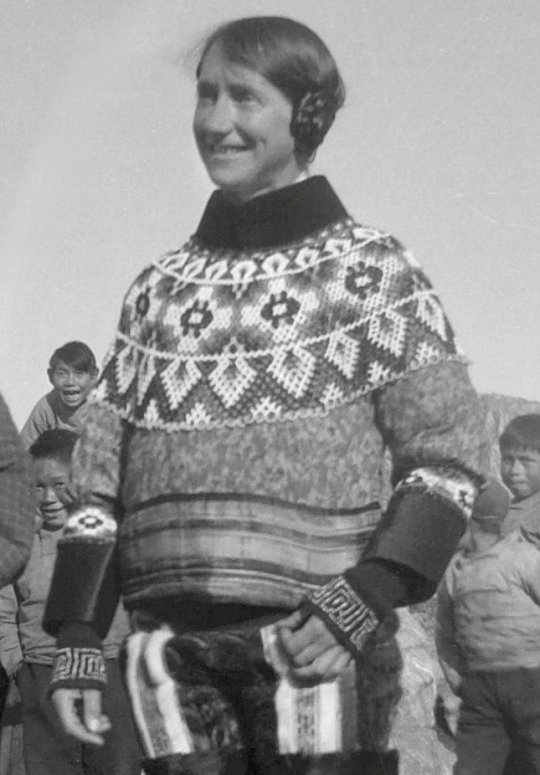
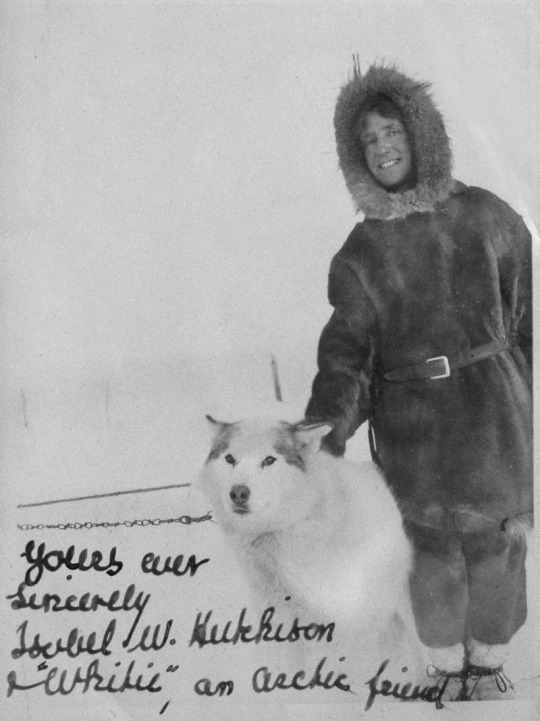
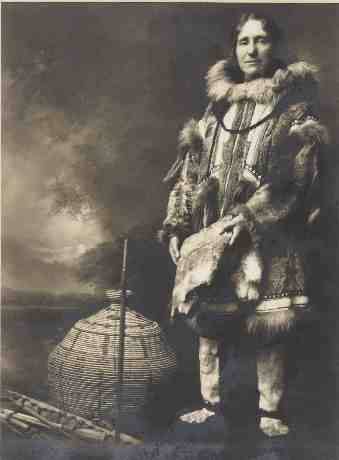
30th May 1889 saw the birth near Kirkliston of Isobel Wylie Hutchison.
Isobel Wylie Hutchison was an Arctic traveller during the 1920s and 1930s. She was also a botanist, a writer, a poet, an artist and speaker of numerous languages, so a bit of a polymath.
Carlowrie Castle a Scots baronial mansion was the comfortable upper-middle class home into which Isobel Wylie Hutchison was born in 1889. It was there her father, Thomas Hutchison, a successful wine merchant in Edinburgh, looked after his gardens, and passed on to Isobel his fascination for plants and his habit of meticulous note-taking. Although called a castle, Carlowrie was built between 1852 and 1855, so was never a defensive structure, but a luxurious home.
Isobel’s father, Thomas Hutchison, was a successful wine merchant in Edinburgh, he was a keen gardener and passed on to Isobel his fascination for plants and his habit of meticulous note-taking.
From 1917-18, she studied at an agricultural college, after which, she visited a number of countries around the Mediterranean region. But the sudden death or her father was subsequently followed by the loss of both her brothers. Isobel was left in a darkened place with a deeply grieving heart. Walking became her escape.
At a time when women were expected to stay at home, dressed in petticoats and tending to domestic duties, Isobel would often leave home for several days – much to the despair of her mother!
A Gaelic speaker, she had soon covered Scotland, including a trek from Blairgowrie to Fort Augustus, and began to look at bigger challenges. She wanted to spread her wings and fly away, and Iceland seemed like a good place to start.
Iceland, which she visited in 1925, was both a test and a revelation. She was told that she couldn’t walk the 260 miles north from Reykjavik to Akureyri because there were no maps, no guides, and it was far too dangerous. But she proved everyone wrong and then set her sights on another goal: Greenland.
By now, Isobel was making a name as a traveller in the Far North. She had written books about her experiences in both Iceland and Greenland. However, she hadn’t quite finished her Arctic adventures! She made arrangements to travel to Alaska and Northern Canada to explore and again, collect plant specimens. In May 1933, Isobel left Manchester and went by ship, riverboat, train and also plane, to reach Nome in Alaska.
Eventually, she arrived in Barrow, in the north of Alaska, where she transferred to another small vessel before the Arctic Ocean ice began closing in, making it impossible to travel any further. Isobel was forced to stay in a migrant Estonian’s hut for many weeks until the weather situation improved. Although her journey had come to a halt, it was an opportunity for her to visit local Inuit families, walk, travel by dog sled and stay in igloos. Eventually, she continued her Arctic trip with a 120-mile dog sled journey and crossed over into Canada. After many months in the Alaskan and Canadian Arctic she eventually returned to Scotland, having been away for around a year.
Unable to obtain permission from the Soviet authorities to visit Eastern Siberia, Isobel’s next northern journey was in 1936, to the Aleutian Islands, off the coast of Alaska. This thousand-mile long archipelago of both large and small volcanic islands draped like a gigantic necklace between Alaska and the Kamchatka Peninsula in the far east of the USSR. These islands were inhabited by Aleut people on treeless terrain and were exposed to continuous windy, foggy and stormy weather.
The Aleut people of the islands were able to live in such extreme conditions because they managed to catch a range of marine life. Fortunately, she was able to visit many of the inhabited islands by way of US government vessels. Invariably, landing on the islands involved negotiating heavy seas in wild conditions. However, when she did make land, she met with the local inhabitants, generally explored and was able to collect her plants.
The onset of World War Two curtailed any plans for further journeys into the Arctic. After the war, she completed a number of long treks, including walking from her home in Scotland to London, from Innsbruck to Venice, and from Edinburgh to John O’Groats. Isobel Wylie Hutchison passed-away at her home in Carlowrie Castle in 1982, aged 92.
The Arctic journeys of Isobel Wylie Hutchison were extraordinarily daring during a time when such trips were unheard of for a single woman. She developed a real passion for the North as she explored various regions of the Arctic world. Isobel was a true adventure traveller, enjoying the uncertainty of her journey, taking calculated risks, but being utterly intrigued by all she saw in the Far North.
28 notes
·
View notes
Text
HUNGARIAN PAGANISM (part 1; english version)
The tree with the moon and the sun
The tree has 9 branches, each can be described as gigantic forests. Winds are created when these branches swirl and tremble. Somewhere between the branches the sun and the moon can be found
This tree can only be found by 'special people', those who were born with teeth, have extra bones/muscles. These people are shamans. (Hungarian shamans are called táltos/tátos/tátus or another form of the word). The reason for that is because this tree connects the world on top, the world on the bottom and the world in the middle (our world). The motif of this tree can be found as decoration (such as on jugs, I will touch on that later in this post)
This tree is also called "the tree that reaches the sky", "the tree without a top", in folktale descriptions such as "the amazing tree" are also found and without a doubt these describe what cultures with a similar belief system would call the "tree of life" or the "tree of the world"
Of course, this "tree of life" can also be found in Indo-European cultures, let's not forget about the tree that's found in Nordic mythology. However, there is a clear sign that tells us the tree found in Hungarian paganism is more similar to what cultures where shamanism is present believe in than what we see in Nordic mythology and that is the placement of heavenly bodies on the tree. The tree of life in Indo-European beliefs do not have heavenly bodied between its branches while the Hungarian one does and that's the same as with our relatives around the Ural mountains (where Hungarians originated from) and Siberian people. Here are just some (mostly) Finno-Ugric nations as examples;
In Finnish culture: "the oak tree that spits fire", "the willow of Rutimo", this tree is able to cover the light of the sun and the moon
In Estonian: a large oak tree that can dim the light of the planets
In Samoyed: oak tree covers the shaman's drum
In Ket: the tree of the world on the boards of a sleigh; the tree sun and the moon are either on the two sides of the tree, or the tree grows from the sun itself; animals surround the tree
In Altaic Turkish: a tree that grows in the middle of the world, here it's a pine tree that's top reaches the house of Baj Ülgön (if it's not spelled correctly I'm sorry, I only saw it written in Hungarian)
In Mongolian: on amulets
In Evenki: The shaman's tree is a representation of the tree of the world (but more on that later)
In Manchu (especially groups in the south): seen on amulets, wedding veils (I'm not sure if veil is the right word for it) ;deer and birds can be found around the tree
In conclusion, this tree that reaches up to the heavenly bodies are widely known in Uralic + Siberian cultures.
Here are some images to help you get a better understanding of how it looks like as decoration.



1-3. Images of the tree of the world from Hungarian regions

4. Image of a drum of a Samoyed shaman with the tree of the world


5. Ket tree of the world with the sun and the moon on its two sides, as well as animals
6.Ket tree of the world with the sun at its roots, surrounded by animals

7. Image of an Altaic Turkish tree of life on a drum
These are mostly things I read from a book by Diószegi Vilmos + my own research and knowledge but I will always specify if it's only by the book or my own research as well
#a little late but i got around to posting about it eventually#sorry for everyone who had to wait a long ass time for this#hungarian#hungarian paganism#hungarian witchcraft#witch#witchblr#witchcraft#hungarian witch#shaman#shamanism#hungarian shamanism#sámán#sámánizmus#belief system#tree#tree of life
67 notes
·
View notes
Text
MEET THE MUSE POWER HOUR!!
━━ take a seat and REPOST this detailed little bio with criteria to introduce the world to your muse. no reblog karma or tagging ━ if you see this on your dash, feel free to partake in it!
☆ ━ B A S I C S .
NAME:: Eiríkur A. Sævarsson / Republic of Iceland
NICKNAME(S):: Eiki with family, Ice by others (call him Ice Ice Baby and you get hit)
AGE:: 1,147 yo, stuck at 18 in human age
GENDER:: male, he/him
NATIONALITY:: Icelandic
☆ ━ A P P E A R A N C E .
EYE COLOR:: a very pale blue actually, but being an albino and having so little pigment in his eyes, the blood vessels of his retinas show through the iris and make his eyes appear almost violet in colour... his actual eye colour can be hard to tell
HAIR COLOR:: white as snow due to albinism
HAIRSTYLE:: short/medium length, usually tousled beyond hope. He has thick, straight hair (tho a few unexpected waves often appear here and there) that has a mind of its own. On top of that, his home country is known for its unpredictable weather and high winds so any of Eiríkur’s attempts to style his hair nicely will be in vain within a few hours. The end result looks as if he hasn’t brushed his hair in a few weeks
HEIGHT:: 180 cm / 5′11′‘
WEIGHT:: 67 kg / 147 lbs
BUILD:: lanky, very narrow frame, gangly and awkward with legs for days... you know that teenager stage where it looks like someone attached a string to the top of their head and pulled up? that what I’m trying to say is he’s like a noodle
TATTOO(S):: N/A
SCAR(S):: covered in burn scars thanks to being volcanic (plus a few “oopsies”)
PIERCING(S):: N/A
PREFERRED FASHION:: his beloved lopapeysas paired with black skinny jeans and a nice pair of boots (either ankle or knee high). Often wears all black or dark colours (dark blue, dark grey, deep mossy green, brown) and combined with his white hair and pale skin, ends up looking like he’s escaped from an old b&w photograph. He doesn’t care for accessories other than a pair of earbuds either plucked in his ears or looped around his neck. Usually wears two layers (wool can be itchy directly against the skin) and when the weather gets colder, he adds a furry-hooded parka and gloves to his ensemble but often skips other warm items of clothing like scarfs and hats
TYPICALLY SMELLS LIKE:: his asthma doesn’t handle strong smells so Eiríkur doesn’t wear cologne or use any scented soaps or shampoos, usually he only smells clean, a little musky, a warm vanilla kind of smell like an old and beloved book. Residual smells from his daily life may include wool, animals, coffee, rosin, etc. Sometimes he may carry faint hint of sulphur, again, thanks to being a volcanic nation
☆ ━ P E R S O N A L I T Y .
POSITIVE TRAITS:: allocentric || appreciative || calm || caring || challenging || charming || creative || compassionate || dramatic || efficient || focused || imaginative || liberal || loyal || neat || non-authoritarian || observant || witty ||
NEUTRAL TRAITS:: stubborn || perfectionist || sarcastic || confident || prideful || competitive || rash || unsentimental || artful || casual || complex || emotional || honest || outspoken || sensual ||
NEGATIVE TRAITS:: abrasive || argumentative || blunt || crass || cynical || egocentric || fatalistic || hesitant || indulgent || irritable || lazy || libidinous || meddlesome || moody || neurotic || passive || possessive || vague ||
LIKES:: animals (especially horses), reading books and studying, learning new things, Nordic Noir, true crime podcasts, sci-fi, listening to music, playing music, nice shoes (esp tall boots), feeeeesh (fish is dead serious business), coffee, pancakes, ice cream, liquorice, sweet pies, pastries, all kinds of sweets tbh, birdwatching, windowshopping, hiking, wide open spaces, having the newest gadgets, NatGeo documentaries, knitting his own sweaters, cheerful and optimistic people, dark humour, bad puns, witty jokes
DISLIKES:: being treated like a naive child who doesn’t know how the world works, feeling insignificant and unheard (read: being ignored), his family (depending on the day with Denmark but Norway is quite solidly on the black list), pretentious people (England), pointless decorum, dishonesty, indirect communication, power distances, deadlines, other people’s insistence to punctuality, and all other useless “hassle”, people who are busy just for the sake of being busy, people who call Icelandic horses ponies, people who diss his traditional food, judgmental people, people and things that (dare to) tower over him, people who pick on others, people who dislike animals and/or animals dislike them, snakes and spiders and other creepy crawlies with too little or too many legs (he feels very conflicted about Sleipnir), neckties... (cut for length)
PHOBIAS / FEARS:: being abandoned, being powerless, lacking a voice and a purpose in the world, getting attached to people, having his trust betrayed, death and dying (both his own and other people he unfortunately finds himself caring about), asphyxiation, needles (or any medical stuff really)
HABITS:: wearing earphones 24/7, always either listening to music and/or singing or humming under his breath, wearing all black clothes, speaking his mind regardless of any and all consequences, siding with the underdogs, showing up at least 15 minutes late to any engagements, reading ferociously about the topics that interest him so that when the conversation lands on those topics he can obliterate his opponent, getting stuck on wikipedia rabbit roles, second-guessing and arguing with himself, taking an average of three days to reply to texts (just call him if you need something), showing up to visit unannounced, baking about once a week, always having homemade desserts to offer to guests but refusing to say they’re homemade
☆ ━ R E L A T I O N S H I P S .
SEXUAL ORIENTATION:: demisexual
ROMANTIC ORIENTATION:: biromantic
RELATIONSHIP STATUS:: something may be afoot with Sarafina ( @orkidpayanke )
☆ ━ H E A L T H .
CHRONIC CONDITIONS:: moderate allergic asthma, PTSD of abandonment, a few specific phobias, hayfever, dry skin and eczema (melancholic by nature but does not fill the criteria for depression)
ADDICTIONS:: caffeine; he can definitely be a bit dangerous to deal with without it
ALLERGIES:: dust mites, pollen, mould (main triggers for his asthma but almost any irritants can set him off: tobacco smoke, air pollution, ash/volcanic fumes, perfumes - please don’t wear strong perfume around him - cold air, dusty rooms, chest infections), also gets a rash around his face and neck from strong sunlight
☆ ━ H O M E .
PLACE OF RESIDENCE:: a house by the sea in the outskirts of Vogar
METHOD OF TRANSPORTATION:: by car if the destination is more than 5 mins away (or alternatively he’d like to commute by horseback but for some reason they tell him it isn’t “professional” and that he’s “making a scene” in the modern day)
PETS:: four Icelandic horses, two cats, and a dog
☆ ━ W O R K & E D U C A T I O N.
JOB:: government “intern” / eternal student, he reads over miscellaneous paperwork (sometimes he jokingly calls himself the PM’s spell-check) and travels for diplomatic missions. His govt is understanding of his physical youth and thanks to the peacefulness of his nation, are willing to allow him time to study and learn the ropes of nationhood (sometimes Eiríkur complains that they could give him more work). In his free time he also volunteers in the local Search and Rescue group
SCHOOLING:: he learnt the basics of survival, the ancient laws and etiquette from his medieval chieftains and later Norway. While living in Denmark he had various tutors and received the standard education of a noble boy for the era. In the modern day he’s enrolled in the local university and does online courses on various subjects that spark his interest. Has completed degrees in Icelandic Language and History at this point, and the rest of his credentials are coming along slowly
SPOKEN LANGUAGES:: Icelandic, Danish, English, German, French, Latin, Old Norse, and to a (much) lesser extent: Norwegian, Swedish (tho he might just be speaking Danish without the stød), Polish, Lithuanian, Latvian, Estonian, and Finnish
SKILLS:: playing the violin and piano, singing, chess, animal husbandry and horsemanship, reciting the sagas and medieval law forwards and backwards by heart, baking, story telling, braiding hair, knitting, quick memorisation of both useful and useless information, wilderness survival, can always point true north, and also has a truly spectacular talent for misplacing things and getting lost
☆ ━ R A N D O M .
QUIRKS:: miracle kid that honestly should have died more than a few times already (bc his own land is constantly trying to kill him), might just be indestructible at this point, now insists on having an opinion in everyone’s business (to not lead an empty existence), also insists on acting tougher than he is, covers up most of his emotions with an explosive temper, has a tendency to get into petty arguments (esp with England), never uses the word “please”, is a neat freak, had a Viking fanboy phase in the 1920s (rumours say it might still be brewing under the surface), cannot tie a necktie without almost hanging himself, actively rebels against all social rules both on personal and national level, and is always down to fight
RELIGION:: Protestant Christian (nominally part of the Evangelical Lutheran Church of Iceland, but mostly agnostic in practice)
THEME SONG(S):: Síðasta kveðjan - Árstíðir
#many are difficult to see through (headcanons)#major headcanons#me introducing my muses: and here we have a belligerent beanpole#the reason this took me so long is actually bc I had somewhat hard time thinking of stuff Eiki actually likes xD
4 notes
·
View notes
Note
For the book meme! 2, 3, 10, 11, 15, 16, 19, 21, 22, 23, 27, 30
If that’s too many, just pick a few haha
already answered: 3. here 11., 15. and 19. here 21. here
2. What’s the worst book you’ve ever read, and why?
i was going to make a cheeky comment about every single estonian ya book being awful - i've had to read a whole bunch of those for school and it was a miserable time. i do not hate ya by default, but i think estonians are just singularly bad at it. but thinking about it some more, i actually have a more recent example of this, that i'll talk a bit more about for question 22
10. The book(s) you bought because the cover was pretty, and whether it was worth it
i'm way too stingy to buy anything just for the cover being pretty lol. i guess i sort of bought the balloon buster by norman s. hall because i thought the cover was hilariously action movie poster-y and i've got a terrible case of the giggles every time i see anything about balloons (or the term balloon buster tossed around), but i had a pretty solid idea that i was going to at least appreciate it.
it was worth each of those 4 us dollars i spent on it!! (i honestly feel like it's something i should scan and shove at archive.org. i was oddly Moved by the author)
continued under the cut :’)
16. The book that you don’t dare reread for fear it won’t be the same any more
for the longest time, it was the harry potter series. as i said before, i'm not much of a rereader so i've only ever read them once and when i was 17ish, i thought, hey, it might be fun to revisit, especially since it had been 10ish years since i read the first one and 4 since the last. but then the casual vacancy came out, which my dad read out loud and it was so bad. and i was forced to confront the fact that the series might not hold up on a reread.
i guess, in a way, this is still true. for all of jkr's fuckery, it's a series i had a ton of fun reading as a kid and talking about it with friends and i don't want to ruin this memory of it. i just have no active plans to reread it anymore
22. The book you finished even though you hated it, and the reasons why
a closed and common orbit by becky chambers. i really wanted to like this (and the wayfarers series in general) and, in theory, it absolutely felt like something i could get into? but if i was able to be like Eh Okay at the first book, this took everything i already was not especially into in the first book and made it more prominent.
it's very much a character study, which i don't think is a bad thing at all, but in this case it doesn't quite work, because the author is so averse to conflict, that there's barely any force propelling the character development forward. and it also makes all the characters feel the same, beyond the superficial stuff like their hobbies, and if you're not attached to any of them, it's just that much harder to get through it. compared to the first book, this has a much smaller cast too, so your choices are that much more limited. it also insists on spoonfeeding you everything about the setting in a way that just feels grating after a while.
as for why i continued reading it... by the time i realised that this was absolutely not working for me and was, in all likelyhood, not going to get any better, i only had like a 100 pages to go, so i struggled onwards
23. The book you expected to hate, didn’t, and then got angry about not hating
the only books i've read while expecting to hate them were the aforementioned estonian ya books for school and i did not like any of them. other than that, i just don't pick up books i think i'm going to hate. i can see the fun in doing this, but personally i have no patience for it
27. The book you’re embarrassed to admit you’ve read
on the whole, there's nothing i'm really ashamed of having read and any embarrassment at admitting to anything depends more on the context. sometimes i don't like talking about books pertaining interests near and dear to my heart with people closest to me, because it's just the kind of vulnerability i am Not about, but at other times i'll lead with that information, because it gets people's attention. i am embarrassed to talk about fantasy and sci-fi novels that i've read with my parents. no matter the kind of books i talk about with my coworkers, eventually someone's gonna be like 'geesh i should read more' and that's just no fun, so i don't usually bring anything up
30. The book you read the blurb of, constructed a version of in your mind, and were promptly disappointed by once you finally got around to actually reading it
the lodger by marie belloc lowndes comes to mind - before reading it, i had made it out to be a far more tense affair, but in the end it was more of a character study of the protagonist than a thriller/mystery. not, strictly speaking, a terrible book or anything, it was just not what i expected or wanted at the time
3 notes
·
View notes
Text
Harassment by Russian security services
I got into trouble with the Russian security services.
This happened approximately in 2015, 2016. The original motivation for the Russians initial approach to try and coerce/intimidate me is not known for sure, but it's most likely related to a political blog I was writing here in Finland from 2013 to 2016 approximately. The other equally plausible candidate reason, has to do with my brother, who I think is almost certainly working to benefit the Russians. He is a fairly big chief in the banking business, responsible for a dozen or so banks in the Southern Finland.
What was it like at first getting into trouble with the Russians?
Preparatory phase
I believe there was a groundwork phase in this which involved collecting so called "Kompromat" or material to be used in extortion later. This kind of extortion doesn't work on me, due to my personality. But of course they couldn't know that in advance. Anyway, I think I got under surveillance by the Russians somewhere around 2014, but I did not suspect anything at this point, and there was no cue whatsoever that would've aroused my suspicions at the time.
Soft initial approaches or probes
The first concrete interactions with the Russians occurred somewhere around late 2015 and early 2016. This involved fairly subtle things like people contacting me on social media and saying weird stuff, but I didn't really suspect this had something to do with the Russians, I only came to realize this later. Additionally in the spring of 2016 there was some in person approaches which were fairly distant, but they were kind of like testing how I would respond to certain things I'll skip explaining this time.
Actual recruitment/whatever effort
When I went to this construction school which lasted 2 years it was also attended by an Estonian-Russian person named Andrei. He was first of all a really big guy, somewhere between 190-200 cm, and probably well over 100 kg. He wasn't a jerk or anything, though, but his behavior was a bit strange. Anyway I believe the plan for the Russians was to recruit me, and that it was this Andrei persons task to get it done during this 2 year education. And this involved subtle harassment and intimidation, like veiled threats and such, and they were pretty tricky, like bystanders wouldn't detect it very easily. This was achieved by using material collected elsewhere to substantiate the intimidation, basically hacking my computer and monitoring my online activities, and that sort of thing, provided material to use for the intimidation effort.
This I think didn't go so well, because first of all i suspected something was going on, but I didn't know what. But my initial attitude was that I tried to reject these approaches. Like when this Andrei person would ask me to do something with him, or something like that, I basically politely declined.
Escalation of matters
So basically I started thinking that this person is probably related to the Russians and their security services, and later I came to realize the things that had happened earlier, were probably related to the same problem. First of all I started talking to people saying that this person is probably related to the Russian intelligence, like the KGB/GRU type of people. I didn't really know much about the entire topic at the time, but I think the Russians tried to misdirect me and kind of lead me to think that it's about something else. Well this kind of backfired too, coz I started talking about how they're trying to misdirect me, or basically something like that. And I wasn't 100% sure yet, that this was really the correct explanation for what was going on and as I developed alternative theories, like maybe I was just targeted online by some hacker, and the rest is just some weird coincidence.. Well the Russians tried to reinforce that, by trying to mess with me online making it look it was just some random hacker. Except, it didn't look like it was a random hacker, but instead, more like someone was trying to make it seem like that. So that didn't work so well.
This whole thing also caused me some anxiety so I tried to seek some help regarding that. Luckily though, or unluckily, depends how you look at this, I was already rather well-read on psychology and such matters, like I had watched/listened to hundreds of hours of lectures, read several books, and could name various disorders and understood a lot of stuff related to that. I wasn't exactly an expert in that I didn't have a formal degree, but for a random person, I was fairly knowledgeable.
Discrediting strategy
So basically when I sought help for this anxiety problem, the Russians picked up another approach, they decided to try and make it look like maybe I was just imagining it, and instead incorporated these aspects into the harassment, which kind of sounded like if you'd try to tell someone about it, they might think.. well is that really what's going on? Or is that just what this person thinks is going on?
So that became their number one approach. Regardless of what I would believe about the case, they wanted to make sure, no one else would believe me. Or at least they'd be suspicious and think there are some alternative explanations to what's going on.
This sort of worked, except, it didn't, because I never really started to question these entirely logical and empirical observations, but it worked in the sense that if I would go through these events only superficially or not to a great enough detail, then people wouldn't understand why it is that I even thought it is the Russians. Like I would literally have to explain details about what this Andrei person said, and what some other person did, and what happened online at the same time, etc.
Literal death threats
So the most concrete of all the threats and intimidations I've received, was during a time when this Andrei person said literally the following phrase - although it was in Finnish - "We are going to kill you". So, you might think maybe there was some other reason for him to say that, or isn't that just kind of odd approach for intelligence to begin with? Like they wouldn't be that foolish, would they? But it was complacency from the Russians part, they had this context set up that would kind of work as a cover story, but regardless it wasn't a very smart thing to do. Whatever their approach is, the fact to the matters is, that there's a person I think is probably related to the Russian security services, who I think has tried to intimidate me, who is Russian speaking and ethnically Russian, and who literally told me they're going to kill me. Whatever explanation you're trying to cook up for this, well.. it would be kind of strange that this had nothing to do with the Russians, yet at the same time, this event took place.
There were some other threats but it was more like a psychological game, in which the Russians tried to balance the threat so that, it wasn't exactly clear if they really wanted to threaten me, or was it more like they just wanted to make a subtle enough threat that I could interpret it that way, but when I would try and explain it to someone else, they might be like.. well maybe that wasn't an actual threat, like maybe it was just a coincidence? And so, I didn't think it was with intent, it was more intimidation, without truly meaning the threat aspect.
Contacting the authorities
Anyway this whole problem developed several years and there are all kinds of things that happened, which of most I'm just skipping, but basically I contacted the police and the counter-intelligence for the first time in February 2020. So that's already over a year ago, but considering how early this issue actually started, it's quite late.
This is mostly because I didn't want to contact the police. I figured that if I'm dealing with the Russians, my problems might just get worse if I start to make a really big fuss out of it. Additionally I wanted to create an incentive for the Russians to leave me alone, and sort of allow this thing to de-escalate. However, that wasn't what the Russians wanted, and so the things eventually escalated anyway. And I went to contact the police, regardless of thinking that rationally, it's probably not the correct decision.
However, when I went into the police station, the Russians had arranged for a couple of people to wait outside the office and subtly try and discourage me from making my report. Well, I ignored them. The police officer was dismissive and their attitude was that I should probably just leave, until I mentioned that well there was also this literal death threat, which kind of impelled them to have to try and take it more seriously. But anyway, they just gave me like an email address, and I figured that if the police can't handle this case, I mean they clearly had zero structure or policy in place, which would allow them to be capable of dealing with something like Russian intelligence. So I basically just gave up on trying to deal with the regular police. Although I did call the police later, and explained generally what was going on, but they said they can't do anything, because of the nature of the case. Like there's too many people involved, the part played by each individual is too small, they can't really investigate a single person, and they don't know where to start. I mean they just couldn't do anything.
However, I also contacted the counter-intelligence. And well, my first impression was that the Finnish counter-intelligence is pretty amateurish and hasn't even taken into consideration really basic stuff, like how do you actually submit information about a case like this, and they hadn't made it possible, to give information, in a way that was secure. Like basically they said that okay tell us about your case and send us an email. So, like isn't there a small chance there would be a motivation for revenge, from the Russians, if I just start emailing details about their activities to the counter-intelligence?
Also how do I even know that the emails reach their destination? And that the contents are correct? I mean I've had some cyber harassment in the process, which involved my computer being clearly hacked. It seems like this could be an issue.
But anyway, they didn't have a solution for that, and didn't even seem to understand this is a problem. So I guess our Finnish civilian counter-intelligence, just kind of sucks, unfortunately.
But regardless of me being severely disappointed in our society, and in our authorities, I did eventually supply them with some details about the case, and they told me I should supply them more details, which I've considered doing, and for various reasons have sent some emails and such.
1 note
·
View note
Note
Right, so I've been learning Estonian for a few months now, and I think I have a good enough vocabulary and general understanding of it that I can start the immersion process. I have the music part covered, but are there any Estonian books/poems/shows/movies you'd reccomend I read/watch?
Since I don’t know your level of Estonian, the suggestions are going to be rather broad.
For books, if still in the beginning stages - anything by Leelo Tungal, Aino Pervik and Eno Raud. All of them have also written poems. They’re children’s authors, yes, but the vocabulary used comes handy to both Estonian kiddos and those learning it as a foreign language.
More advanced level books are Tõde ja Õigus (basically treated like a bible), Rehepapp, Mees kes teadis ussisõnu, Kevade.
I mean Harry Potter books are also not Estonian but considering if you have read it in your native language its great learning tool to read it in the target language, an idea…
For poems - Doris Kareva, Marie Under, Lydia Koidula. Also our national epic Kalevipoeg an epic poem so… (but there’s not a lot of Estonians who voluntarily read the entire thing).
Shows, uh - anything https://etv.err.ee/ lets you see that’s not region-locked? I mean we don’t produce any TV shows I would recommend exactly… Although I’ve heard Ohtlik Lend (made in 2006) is good.
Movies - Names in the Marble (war coming of age movie, very very important movie), Tõde ja Õigus (again, very important to the point if you haven’t seen it and are Estonians others think you live under a rock), Detsembrikuumus, Mina olin siin, Võta või jäta, 1944, Seltsimees Laps (The Little Comrade), Mandariinid, Vehkleja - I mean basically any movie with bigger actors in Estonia is pretty good and definitely good idea to watch to learn.
Also, Lotte series is about 3 or 4 movies worth of cartoons that are good for beginners because all characters speak super clearly :)
I will now hand the mic over to @anamericaninestonia who also knows a lot of resources (maybe even more!) 💙
18 notes
·
View notes
Text
Curating an Exhibition in 2020: Handle with Care
Architecture exhibition Handle with Care: Tales of the Invisible opens at the Lisbon Architecture Triennale on October 15, as part of this year’s program of the Future Architecture Platform. To mark the occasion, here’s the interview with Sonja Lakić, architect, researcher and curator of the exhibition.
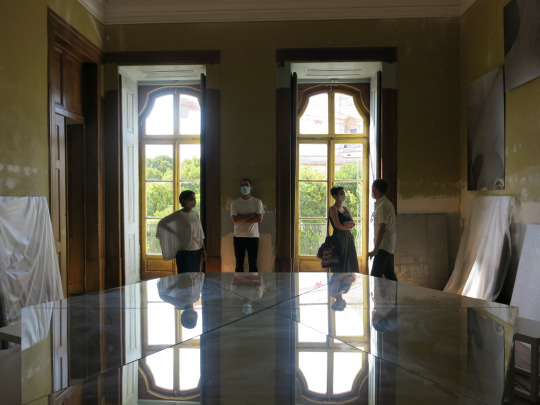
Preparing the exhibition at Lisbon Architecture Triennale headquarters, August 2020. | Photo © Sara Battesti
As we’re approaching the winter season of the pandemic which has pushed the entire world into various forms and intensities of isolation, it seems like there could hardly be a better time to reflect upon the practice of care and its relationship to architecture. Our rooms are becoming our worlds. When you began dreaming up this exhibition, did you anticipate it opening in this context of increased awareness of the spaces we inhabit?
Absolutely not. The only spaces that curating this exhibition was supposed to unfold in, apart from Lisbon Architecture Triennale headquarters, were, obviously, interiors of Future Architecture platform partners institutions that I was, as it was originally planned, about to visit last spring. I would also add interiors of airports and airplanes to the list. Hotels included. I am still curious about all the breakfasts I missed due to pandemic. I, obviously, ended up making my dreams happen in front of my screen, meeting people sitting in front of their own laptops and/or computer screens, mostly inside their homes around Europe. I vividly remember the variety of blankets, cozy sofas and afternoon naps that violently came to an end due to numerous online meetings across Europe, as well as scaffolding outside an apartment in Turin that reminded me on L’Aquila, where I completed my PhD, planting a garden on a rooftop terrace in Lisbon, dilemmas from Berlin, and, finally, being taken next to a window in Barcelona to clap and support all the caretakers. I dreamt inside all of these homes without stepping inside any of them, appreciating them as the new landscapes of care, and, finally, landed in Lisbon: we are all, obviously, still in the mode of the increased awareness by all means, yet, the exhibition will get you covered from A to Z. It is, after all, handled with care.
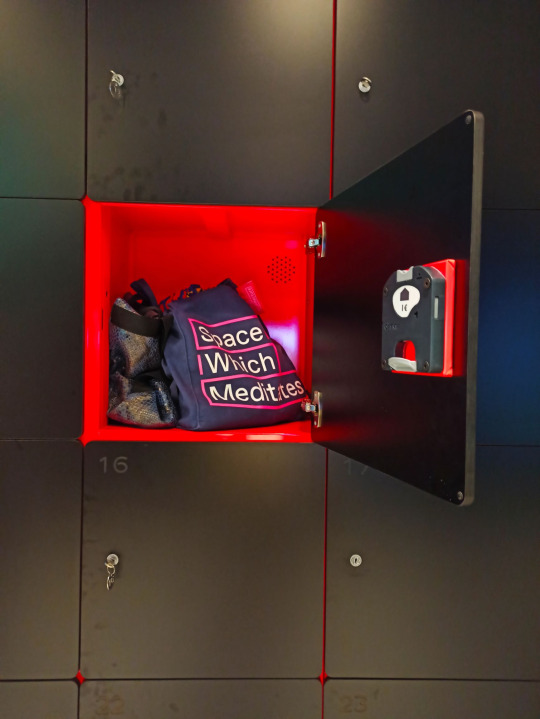
Space Which Meditates: Future Architecture Accessories | Photo © Sonja Lakić
How did your background in architectural research and your lasting interest in lived forms of buildings inform your work on curating this exhibition?
I am somewhat a dissident from the discipline: I work visually, yet, I operate at the scale of the everyday, chasing after the non-evident and doing the storytelling by often using the language of urban anthropology and urban ethnography. I do not believe that architecture is only a physical matter: there is more to the story than meets the eye. That being said, there was only one way to curate the “Tales of the Invisible”: zero concrete. Zero final solutions. Hardly any material architecture. From the very beginning, I knew there would be no space for the permanently built structures: instead, I, again, chose to focus on the human clay and bring different people and thinking experiments to light. I searched for different concepts and ideas, digging deep for passion and determination, attempts and failures, individuals and groups that once made the architecture world turn around, traveling back and forth in time, myself unlearning what architecture may (not) be. There is never a wrong moment to celebrate humankind and this exhibition is, to a certain extent, an excuse to do so: a gentle reminder of what still surrounds us and what we are made of, or, at least, once were.


The creative process: keeping it as analogue as possible. | Drawings and photos © Sonja Lakić
vimeo
Curator's Log. An excerpt. Preparing "Handle with Care: Tales of the Invisible" exhibition for Lisbon Architecture Triennale under the Lisbon sun. | Video © Sonja Lakić
In your curatorial statement, you refer to this exhibition as to “homage to the quirks of the human mind”, “a call to re-think where we stand” and “a gentle reminder that life comes before buildings”. Can this be interpreted as an invitation to (re)consider the political role of architecture?
I, most of all, envisioned the exhibition as a conversation, or, more precisely, a call for heart-to-heart exchange of this kind: my intention and desire is that people experience it and understand it in a variety of ways, yet, in full accordance with who they genuinely are. I never aimed to reach a consensus of any kind since that would mark an end of any debate. I, therefore, thank you for this question: I am more than happy to see that, days prior to the opening, the exhibition already lives its purpose by being interpreted. Thus, to a certain extent, the answer to your question is: yes, this is also an invitation to (re)consider the political role of architecture. What, for example, influenced my curatorial approach is “the awareness to the wonders” that Alberto Pérez-Gómez believes and, moreover, propagates in the book “Built upon Love: Architectural Longing after Ethics and Aesthetics”: we, whoever we may (not) be, should develop and nurture this skill that I interpret as “to stop and smell the roses”. This exhibition does this as well. Referring to your question, I have to say that I, obviously, find architecture political and this is, with no doubt, where consensus is inevitable.
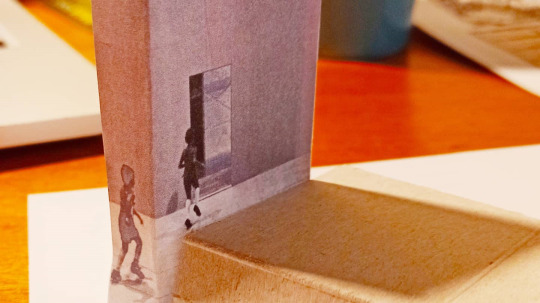
Creating models from a discarded box of chocolate cookies | Photo © Sonja Lakić
Can architecture amplify the human potential for care-giving and care-receiving, and if so, how?
I believe that architecture itself stands for the noble discipline of care. This is why I, once upon a time, decided to study it: I recognised it as an opportunity to care about people while never letting go of mathematics, arts and drawing. For a nerd like me, to be engaged in this wide spectrum of disciplines is even nowadays of crucial importance, and was, therefore, as equally important during the early university days of mine, when I managed to detect traces of psychology and sociology in very few courses I was enrolled in.
Architecture, most of all, is all about a very particular responsibility that first comes with the vision of an architect and next translates to “a program” of how to use a building: this is where one needs to be very careful, while, simultaneously, to care a lot. The program is, say, often a recipe for how to live one’s life, as prescribed by an architect: of course, this rarely happens, for the life itself is not to be tamed. Architecture already amplifies the human potential for care-giving and care-receiving. Or, should I say that there are architects who do so? Maybe that would be more ethical. There are beautiful individual minds and collectives who stand for care by their mere existence, embracing their ethics in their texts and variety of programs. To paraphrase Esra Akcan, one of my favorite minds of all times: architecture can heal. And I believe it should. The process of healing may happen through the process of (un)learning, collaboration with other disciplines, seeing the world through the eyes of the other, while, simultaneously, never ever considering anyone as the other. Same goes for care.

Taking a break in the summer of the 2020: the Sun, the ocean, the drinks, and the disinfectant gel. | Photo © Sonja Lakić
What, however, instantly comes to my mind when thinking about architecture and care, especially the healing process, is whether it is possible for the healing of post-conflict societies, including the country of my origin, that is, the region of former Yugoslavia, to happen via architectural programs that, to put it simply, celebrate life. What if, instead of constantly exposing one to memorabilia that recalls past events and somewhat advocates for the culture of mourning, we take care of people by gently reminding them of all the reasons why it is good to be alive? I am aware that this is somewhat calling for a revolution, yet, this is how “the awareness to the wonders” I previously mentioned may be attempted to achieve, without any actual construction happening: this is where temporary structures, installations and performances and engaging in performative planning and tactical urbanism, could play an important role. We owe it to ourselves, as well as to each of our individual human potentials, regardless of who we as individuals are, to, at least, try, having a little faith in architecture as an event rather than the final say.
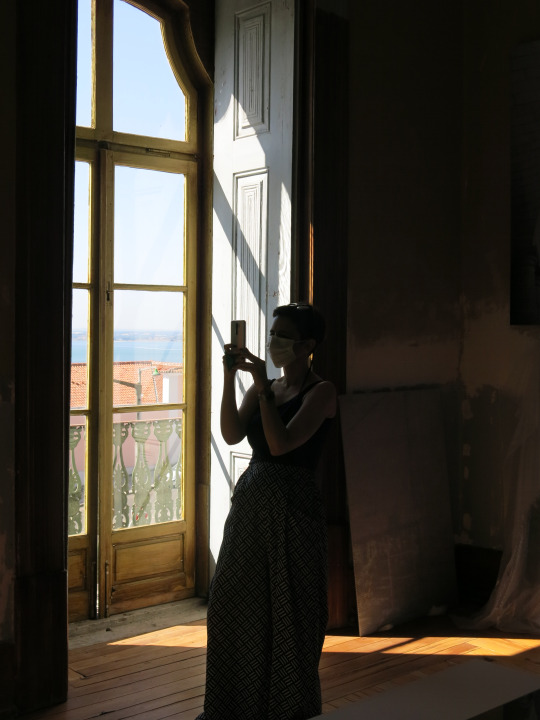
Sonja Lakić at Lisbon Architecture Triennale headquarters, August 2020. | Photo © Sara Battesti
The exhibition draws from the collections of the Museum of Architecture and Design in Ljubljana, MAXXI National Museum of 21st Century Arts and the Estonian Museum of Architecture. What does curatorial collaboration with museums scattered across Europe look like in a time of Covid-19?
On the one hand, it resembled any other “new normal” kind of experience and, in that sense, it was not any different from any of the pandemic-imposed daily routine since it evolved around the absence of movement and the impossibility of touch. Simultaneously, it was quite a challenge: can you imagine curating an exhibition without stepping into an institution and getting to see a collection? I did dig deep within myself, looking for answers, and have to admit that, occasionally, it seemed to be a bit of a challenge. However, I have to say that I am immensely grateful to all the people that I crossed paths with and whom I collaborated with on this project: words are not enough to describe how easy and smooth the overall process was and how helpful, patient and caring were partners from Ljubljana, Rome and Tallinn. I learned a lot and indeed grew, yet, not only in professional terms: rather, collaboration with Museum of Architecture and Design in Ljubljana, MAXXI National Museum of 21st Century Arts and the Estonian Museum of Architecture had a profound impact on me personally as well and was, in this sense, a game changer. They were all extremely devoted and committed, helping me connect with architects and scientists that I, prior to this exhibition, have only read about. Oh, I went places I never dreamed of, and I will come back for more, however, in person. Hopefully no more screens.
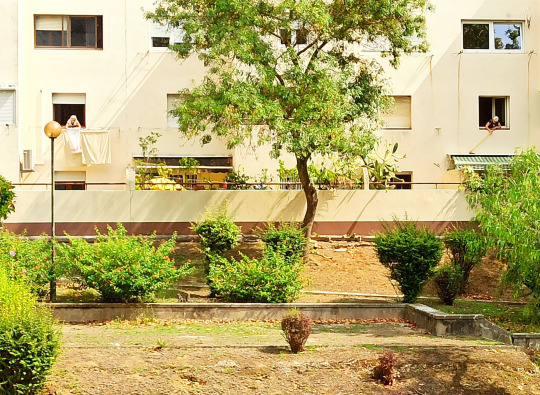
Lisbon people and their balconies. | Photo © Sonja Lakić
A while ago, you stayed in Lisbon as a visiting researcher at ISCTE-IUL; now you’re back to curate an exhibition commissioned by Lisbon Architecture Triennale. What about the city preoccupies you these days? If Lisbon, as a living archive, could preserve one message from this exhibition, what would you like that message to be?
People. People always preoccupy me regardless of my geographical location. I am currently collaborating with ISCTE-IUL again and am also affiliated with ETNO.URB, so there are many big fishes to fry, and I am extremely happy and beyond excited for this. Of course, I could not help it: again, I observed the Lisbon edition of glazed balconies, and I found that one of them is especially dear to my heart, as it conceals the story about the most notorious apartment in the 1980s neighborhood where I found my home.
As far as the message, I would say it is rather evident: life comes before buildings. People first. Always and forever.

Sonja Lakić (1983) is an internationally trained architect and researcher with a PhD in Urban Studies. Her work evolves around open architecture and dialectical urbanism, with a keen interest in lived forms of buildings hence anthropological and sociological aspects of architectural design and the built environment. Topics of her curiosity that she nurtured in Gran Sasso Science Institute and while briefly appointed as visiting researcher at ISCTE-IUL in Lisbon, include the everydayness of architecture, home(making), housing and informality, buildings as living archives, post-conflict societies. Sonja operates across different disciplines and scales, works visually, and collects oral histories, practicing unconventional ethnography and storytelling mainly through photography.
---
By Sonja Dragović
1 note
·
View note